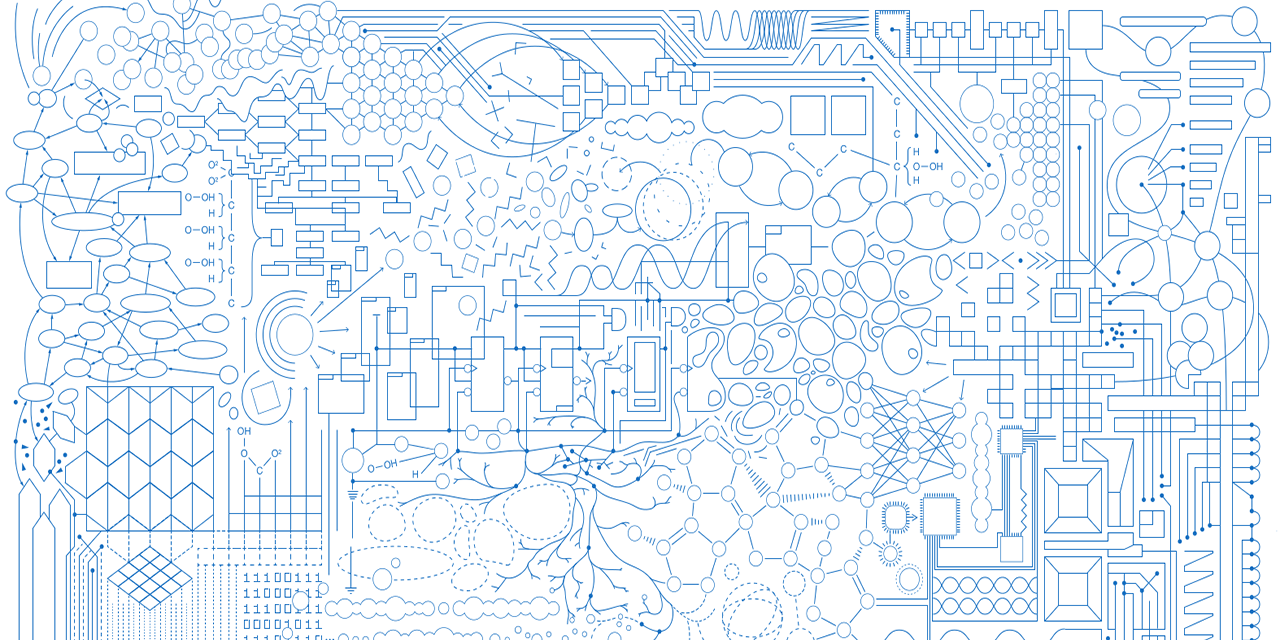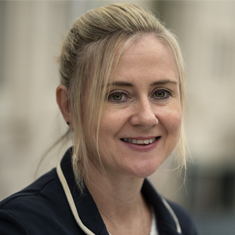Studying Videogames: A 20-Years Old Challenge for the Humanities

GIANMARCO THIERRY GIULIANA
Videogames… Today they are everywhere: they inspire books, TV series and films in the cinema, they fill sports stadiums for competitions, they are used in museums and schools, news and memes that they produce are all over our social networks, they are references in song lyrics and respective videos. Even concerts of videogame soundtracks are now common. They are in our homes and always with us on our smartphones and, last but not least, marketing and merchandising have us finding them in supermarkets as well as in souvenir shops. Their steadily growing numbers of sales are impressive,[1]https://www.bbc.com/news/technology-46746593. including for the public of non-gamers, who enjoy watching videogames on YouTube, Twitch and TikTok. Undoubtedly, for at least 10 years now, they have been the most popular cultural product in many countries, in both the Global East and West. A look at data on the use of video games among children shows that their historical role will likely equal that of the book in terms of influence on the mindset of the new generations.

Gianmarco Thierry Giuliana
Gianmarco is a research fellow at the University of Turin (UniTo), Department of Philosophy and Educational Sciences within the ERC project “FACETS” and a contract lecturer for STUDIUM (UniTo). Specializing on the topic of the relationship between experience and interpretation in game-virtual realities, he has written numerous scientific articles in game studies, semiotics and philosophy journals. You can also find some of his lectures on Youtube.
Therefore, studying video games is crucial not only to better understand the present but also the future. I, an enthusiastic gamer since childhood, starting 1998, am an example of those who turned their passion into a research job. But what does it mean to study video games for a researcher working in philosophy and, more broadly, the humanities? In a nutshell, it means questioning how human beings make sense of video games, both by studying the characteristics and contents of ‘video game texts’ and the behaviour and interpretations of players. At the time when I completed my MA thesis, in 2017, I thought that this would not be very difficult, especially considering that the first studies on this topic were, back then, twenty years old. And yet five years after that thesis, as a post-doc who has continuously worked on this topic, I still find myself facing some of the problems I discovered in that early work! These ‘problems’, however, are precisely what makes the study of video games so interesting both from an academic point of view and in terms of social impact. Over the years, I have been fortunate enough to be able to present my research not only to students and university colleagues but also to game creators, family associations, teachers, psychologists and even doctors. I would thus like to let you know you about my work by mentioning the major themes of humanistic, and especially semiotic, research on digital games.
1) Storytelling & Tenth Art
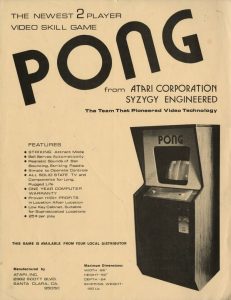
Today we are used to having video games that tell great stories with interesting characters and make us feel emotions and travel to imaginary worlds. Yet, exactly 50 years ago, video games consisted of two white sticks on a black background bouncing a square: that was Pong. What has happened in the meantime? In 1997 the important scholar Janet Murray published her book ‘Hamlet on the Holodeck'[2]Murray, J. (1998). Hamlet on the Holodeck: the Future of Narrative in Cyberspace, Cambridge, MA: MIT Press. in which she outlined the idea that by virtue of its technical and cultural specificities, the video game could become a powerful new artistic medium of storytelling. 15 years later, we can certainly say that she was right, to the extent that today a scholar of culture cannot help but analyse the video game content as shaping our imagination. And yet, at the same time, the stories told by video games do not work in the same way as told in films or books. What kind of story is, in fact, one in which the protagonist dies after a few seconds by falling into a ravine because of his spectator? Even today there is much debate and work on how video games are a unique art form that tells stories by hybridising the languages of previous arts such as film, literature, music, and painting. A hybridisation that makes the video game a true platypus (a nickname I designated and of which I am very proud!) and challenges most previous theories and methods of analysis.[3]Aarseth E. (1997). Cybertext: Perspectives on Ergodic Literature. Baltimore, Maryland: The Johns Hopkins University Press. Hence my work to create a new method of analysis capable of highlighting how a video game conveys ideas through art and storytelling.
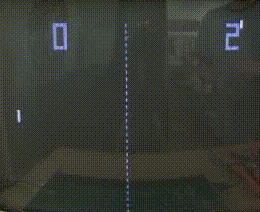
2) The Game
Going back to Pong, there are still many video games today that do not really tell stories and are very successful: from Tetris to Candy Crush. Then, there are also all those games interested in simulating realities rather than fiction: from realistic sports games to Microsoft Flight Simulator. To these, I also add all those games in which the real ‘story’ is, as in sport, that of the splendid performance of their players: from historical fighting games like Street Fighter to MOBAs (Multiplayer Online Battle Arenas) like League of Legends to Fortnite or Among Us. These games without great artistic or narrative pretensions are often the subject of harsh and often unfair criticism. I find that, quite on the contrary, it is precisely on the basis of such games that a part of the academia reflected and still works on that cultural form which has been, so to speak, ‘removed’ from the history of arts and culture: games! Not only has the game, in fact, existed since 2500 B.C. but, as Johan Huizinga writes in his valuable ‘Homo Ludens’, it has always been at the heart of human societies and is a model for thinking and rethinking reality.[4]Huizinga, J. (1985 [1938]). Homo Ludens: Proeve Ener Bepaling Van Het Spelelement Der Cultuur. Groningen: Wolters-Noordhoff. Original Dutch edition. All of the most fundamental categories of language and human thought are in fact called into playing and games: they construct both a subjectivity, a destiny, a temporality and a world of reference. In the humanities, however, scholars interested in play are still a minority as the dominant theoretical models come from studies on narration. A negative stereotype of play as mere ‘entertainment’ still lingers. Thus, an important task in my work consists in trying to remind the academic community that nothing is more serious than playing!
3) Participatory Culture
Whether it is creating and being a detective engaged in solving a case in the world of Disco Elysium or beating up your opponent as much as possible in the latest Dragon Ball Fighter Z, in all cases, video games require players to participate in a committed way. Although academics such as Umberto Eco demonstrated back in the 1980s that the reader and spectator are never ‘passive’, video games certainly give those who play them greater manipulative power over the meaning of the text than previous media do. This critical and creative manipulation of mass culture by its consumers is a major theme in the humanities and social sciences A leading figure here is Henry Jenkins.[5]Jenkins, H. (2009). Confronting the challenges of participatory culture: media education for the 21st century. Cambridge, MA: MIT Press. (Trad. it. Jenkins, H. (2010). Culture partecipative e … Continue reading If, however, in the case of films or books this occurs a posteriori, in the case of video games it occurs in fieri (i.e., ‘in the happening’) and sometimes even a posteriori with the possibility of directly modifying the game files. As such, studying video games also means studying the interpretations, rewritings and creations of their players. For a long time, the study of these ‘personal interpretations’ was avoided by disciplines such as game studies. This was epistemologically justified. Nowadays, however, thanks to platforms such as YouTube or Twitch, these interpretations are themselves presented as analysable texts. My work is in this sense also one of research and collection of materials that constitute a history of interpretations of digital worlds.
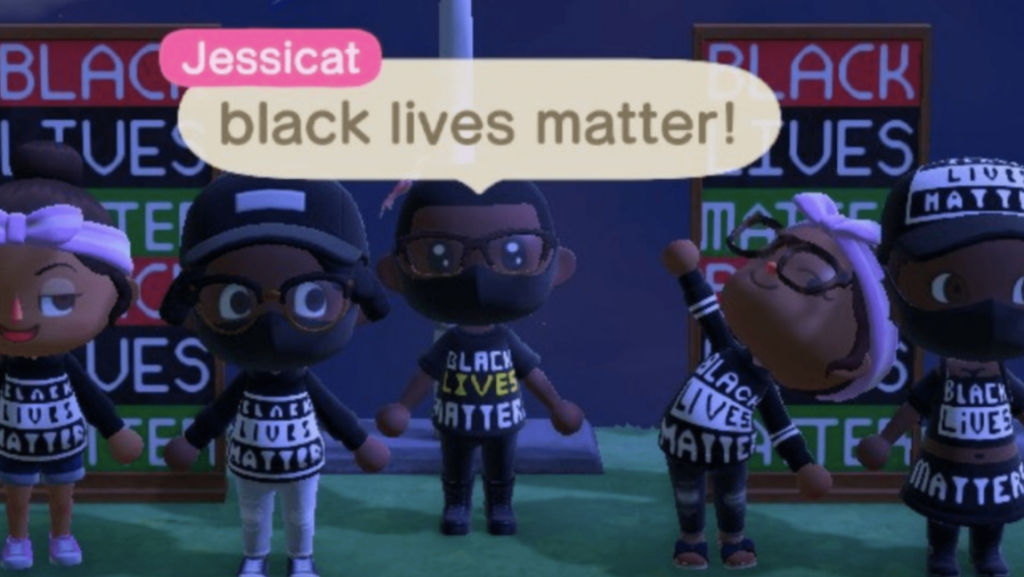
4) Virtual Reality & Digital Technology
A video game is first and foremost software, which makes video games of great interest for studying the processes and outcomes of interactions between humans and digital technology. Algorithms and artificial intelligence are topics of great importance for contemporary societies and have been part of video games since their birth. It is precisely the ‘algorithmic core’, as the very important video game scholar Ian Bogost puts it, that makes videogames and their narratives very different from all other games.[6]Bogost, I. (2007). Persuasive Games: The Expressive Power of Videogames. Cambridge, MA: MIT Press. Moreover, for at least twenty years video games have been ‘virtual realities’ where people get married, manifest, find friends, trade, hold funerals and much more. Studying video games is thus also equivalent to studying the way social reality and human relationships are changing through technology. In my particular case, the aspect of computer technology that I study most closely is the role of digital faces in virtual realities. A trully fascinating topic!
5) Learning
In 2005, the scholar James Paul Gee published an important article in which video games were described as ‘learning machines’.[7]Gee, J. P. (2005). Learning by Design: Good Video Games as Learning Machines. In E-Learning and Digital Media, 2(1), 5–16. https://doi.org/10.2304/elea.2005.2.1.5. Videogames, in fact, almost always involve a great deal of physical and cognitive effort in order to improve one’s performance so that one can win. This learning process has to do with the development of certain perceptual and motor skills, but it also has a lot to do with the rules and content of the game. Those who play a car racing simulator like Gran Turismo develop not only reflexes, but a very deep knowledge of how cars work.[8]https://www.gamespot.com/articles/meet-the-gran-turismo-player-now-driving-race-cars-for-real/1100-6419397/. Similarly, someone who plays a strategy game like Total War will learn a lot about characters, objects, practices and historical events. Even those who play the fictional game Assassin’s Creed 2 will learn a lot about the city of Florence in the 15th and early 16th century and will still be able to find their way around the city today almost as if they had already been there![9] https://www.reddit.com/r/AskHistorians/comments/v5c42/how_close_were_the_cities_of_assassins_creed_2_to/. In ‘author’ games, this learning even becomes emotional and often involves asking players to make difficult choices that are of great ethical relevance. For teachers there is therefore a great deal of interest in the video game medium from the point of view of both its generic learning potential and its educational potential. Finally, this very strong connection between physical action and what is represented on the screen has prompted an unprecedented collaboration between the humanities, philosophy and cognitive sciences. So, if you were to burst into a researcher’s bedroom and see them dancing wildly in VR in Beat Saber, don’t judge them: they are probably working on bringing together classical theories of thought with theories of embodiment!

There are many other interesting aspects to mention but I end this post on this note. I hope I have given you a little insight into my work as a video game semiotician and, above all, to have convinced you (at least a in part) of the importance of videogame studies.[10]In case you would like to read more: http://www.digra.org/digital-library/publications/quilting-the-meaning-gameplay-as-catalyst-of-signification-and-why-to-co-op-in-game-studies/. The importance of videogame research is due not only to the theoretical and social impact of videogames but also to their requiring of a tight collaboration between all those who study and produce them.
Featured image: 2013 hack of Donkey Kong, 1981. More info at: https://www.wired.com/2013/03/donkey-kong-pauline-hack/.
Proposed citation: Giuliana, Gianmarco. (2022). Studying Videogames: A 20-Year-Old Challenge for the Humanities. https://khk.rwth-aachen.de/2022/12/24/5266/5266/.
References
| ↑1 | https://www.bbc.com/news/technology-46746593. |
|---|---|
| ↑2 | Murray, J. (1998). Hamlet on the Holodeck: the Future of Narrative in Cyberspace, Cambridge, MA: MIT Press. |
| ↑3 | Aarseth E. (1997). Cybertext: Perspectives on Ergodic Literature. Baltimore, Maryland: The Johns Hopkins University Press. |
| ↑4 | Huizinga, J. (1985 [1938]). Homo Ludens: Proeve Ener Bepaling Van Het Spelelement Der Cultuur. Groningen: Wolters-Noordhoff. Original Dutch edition. |
| ↑5 | Jenkins, H. (2009). Confronting the challenges of participatory culture: media education for the 21st century. Cambridge, MA: MIT Press. (Trad. it. Jenkins, H. (2010). Culture partecipative e competenze digitali: media education per il 21. Secolo. Milano: Guerini studio). |
| ↑6 | Bogost, I. (2007). Persuasive Games: The Expressive Power of Videogames. Cambridge, MA: MIT Press. |
| ↑7 | Gee, J. P. (2005). Learning by Design: Good Video Games as Learning Machines. In E-Learning and Digital Media, 2(1), 5–16. https://doi.org/10.2304/elea.2005.2.1.5. |
| ↑8 | https://www.gamespot.com/articles/meet-the-gran-turismo-player-now-driving-race-cars-for-real/1100-6419397/. |
| ↑9 | https://www.reddit.com/r/AskHistorians/comments/v5c42/how_close_were_the_cities_of_assassins_creed_2_to/. |
| ↑10 | In case you would like to read more: http://www.digra.org/digital-library/publications/quilting-the-meaning-gameplay-as-catalyst-of-signification-and-why-to-co-op-in-game-studies/. |
Social Change in Ukraine – Obstacles and Opportunities: Conference report

SVITLANA SCHERBAK

On November 16-17, 2022, the Lucerne University of Applied Sciences and Arts hosted conference Social Change in Ukraine – Obstacles and Opportunities. The event gathered scholars from Switzerland, Ukraine, Poland, UK, and Hungary. Having carried out social research on Ukrainian society for a long time, I was invited to deliver a talk on The Rise and Fall of Populism in Ukraine.
Here, I provide a report of this conference, with remarks on the individual presentations. It is important to notice that the theme of the conference was not the ongoing war, even though this undoubtedly shapes the conditions for social change in Ukraine. The conference aimed at developing a socio-critical analyses and fostering dialogue between social scientists on the structure of Ukraine’s society, economy and politics. The focus fell on the potential hurdles to overcome in order for the country to integrate in a sustainable way into the community of European states.

Svitlana Shcherbak
Svitlana is a fellow at c:o/re and a researcher with eighteen years of experience working alongside the research team of the National Academy of Sciences of Ukraine. Her research focus is on ideological discourse in Post-Sovjet States.
There is consensus among researchers of post-soviet countries that the neo-institutional approach provides the most appropriate explanatory framework for the analysis of these societies. The point is that the institutions in these countries differ from those in the West due to very different informal rules. Therefore, the instrumental logic of economic reform and development policy may conflict with informal institutions, unwritten rules, or corrupt practices. Such mechanisms can hijack good intentions and steer processes in an unwanted direction. Concepts elaborated for the description and explanation of Western democracies fail to grasp the essence of post-communist societies. As such, there is a need to develop explanatory concepts and models for post-soviet contexts. It is not accidental, then, that most participants focused on the description of informal backgrounds for institutions peculiar to post-communist space.
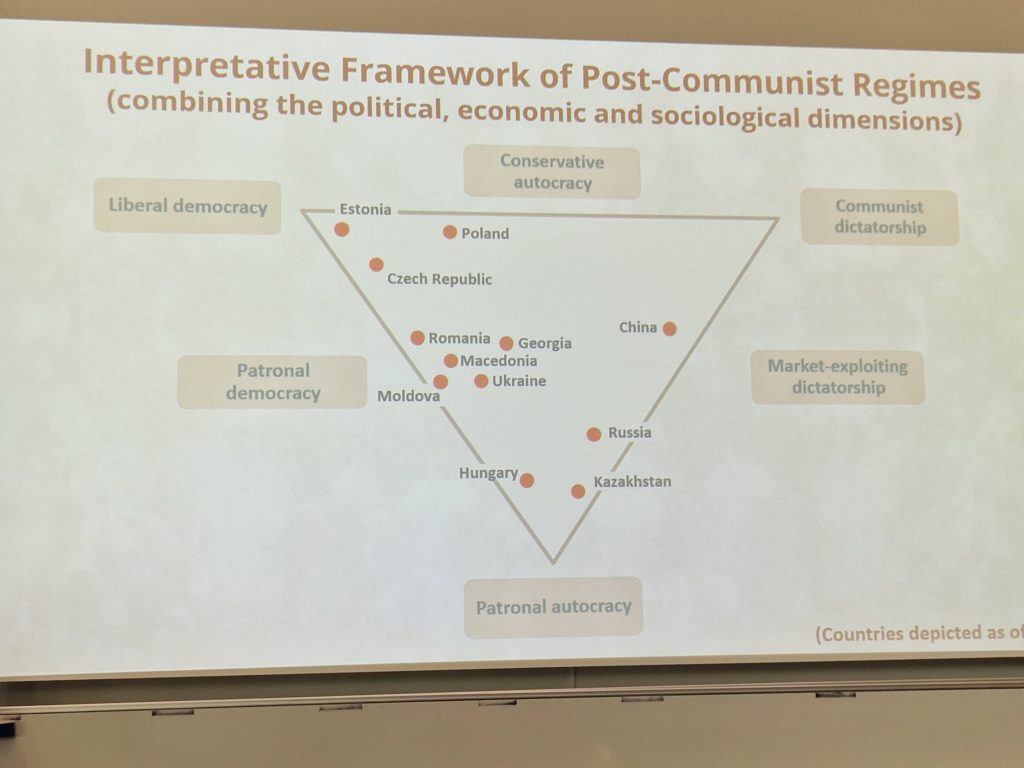
Balint Magyar and Balint Madlovich presented their new book, “A Concise Field Guide to Post-Communist Regimes”, which provides a conceptual framework with an inherent typology of post-communist regimes and a detailed presentation of ideal-type actors and the political, economic, and social phenomena in these regimes. The authors presented how their theoretical model can be applied to Ukraine, through a comparison with Russia and Hungary. They analyzed the Ukrainian context as a “patronal democracy”, both politically and economically.
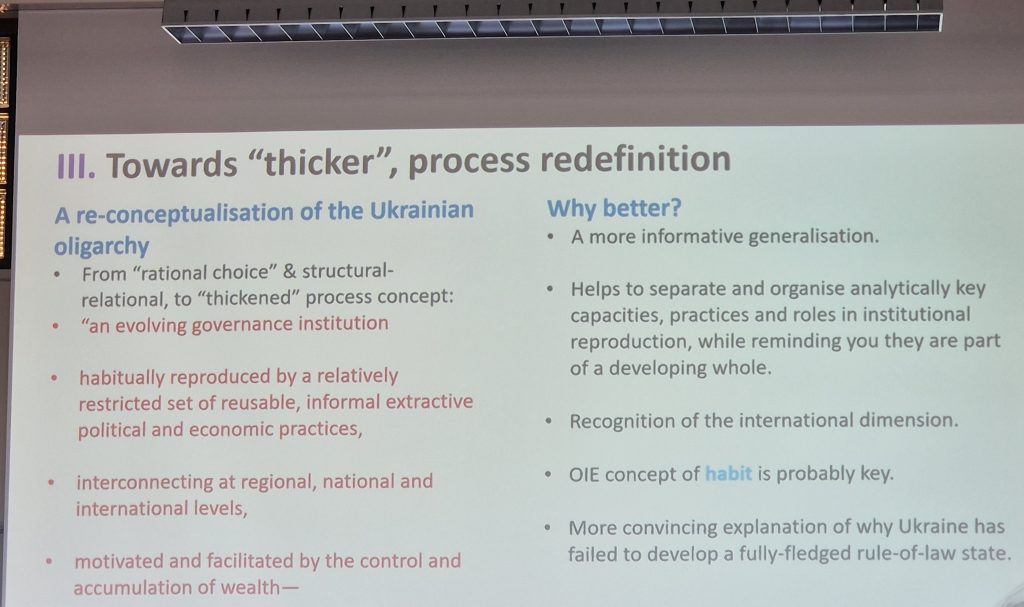
David Dalton, Vladimir Dubrovsky, Oksana Huss, Mikhail Chaplyga and, the organizer of the conference, Michael Derrer addressed oligarchy and corruption in Ukraine in connection with the task of maintaining and recovering the Ukrainian state during and after the ongoing war. They also explored the role of informal institutions in the Ukraine’s socio-politico-economic system. The discussion focused on a future configuration of the Ukrainian political regime, as well as on the perspectives for anti-corruption and anti-oligarchic post-war reforms.
Kateryna Ivashchenko-Stadnik used sociological data to show the main shifts in Ukrainian society since 2014 and the potential for the further development of this society. Jacek Kurczewski focused on the difference in post-communist transformation of Poland and Ukraine. He considered pre-communist and communist legacies, and the social mechanisms of transformation, offering a glimpse into the sociology of attitudes towards law and justice.
Denys Kiryukhin analyzed the reasons for the very high level of migration from Ukraine, due to which the country has been called “Europe’s Mexico.” He argued that before the war there were no structural prerequisites for such high migration dynamics. Thus, he proposed an analysis of migration in a broad context of modern social processes in Eastern European countries and revised the concept of “forced migration.”

My presentation adressed the rise and fall of populism in Ukraine. Whether Volodymyr Zelensky is a populist was a debated question during the 2019 presidential campaign, as his rhetoric and public image met many of the criteria of populism. I argue that it is important to distinguish between populist and nationalist discourses, illustrating my thesis with the rhetoric of the two main opponents during the 2019 campaign. Zelensky promoted the inclusive concept of “the people,” based on citizenship, multiethnicity and regional heterogeneity, which he contrasted with “the corrupt elites”. On the other hand, former President Petro Poroshenko promoted an exclusive ethno-nationalist, anti-liberal concept of “the people” that requires homogenization based on a common language, culture and faith. My view is that after the outbreak of the war, populist discourse lost its relevance and we are witnessing a nation-building process based entirely on nationalist grounds. The main point of differentiation among the presenters’ approaches was whether they considered only exogenous factors of social change in Ukraine or put the country in a broader context, taking into account the inter-regional and transnational division of labor, as well as Ukraine’s place in global economy. The latter approach tends to suggest rather pessimistic expectations about the future of Ukraine.
Proposed citation: Shcherbak, Svitlana (2022). Social Change in Ukraine – Obstacles and Opportunities: Conference report. https://khk.rwth-aachen.de/2022/12/21/5224/5224
Decolonising Advertising through content creation, broadcast on social media, to inspire social transformation
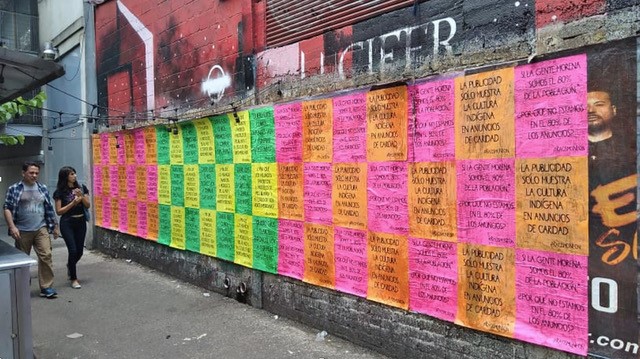
CARL W. JONES
I argue that Advertising in Mexico is a means employed by the ruling class in order to colonize Mexican society. It re-enforces a colonial thinking that started to be imposed five centuries ago by invaders of what is currently called the nation state of Mexico. My argument is based on a theoretical framework that maps the history of key concepts such as Post-colonisation and Decolonization. Anzaldua and Drussel’s definition of colonization from a Latin American point of view, and Mignolo’s observations on decolonization through ‘delinking knowledge’ are applied to advertising to reveal how this field can possibly be decolonized. The basis of the practice part of my PhD by Practice that is discussed in this article are theories of Detournement and Guerrilla semiotics. An important part of the strategy for this practice is using social media to search for solutions that can be reflected back at Mexican citizens in order to inspire a social transformation within the advertising industry.
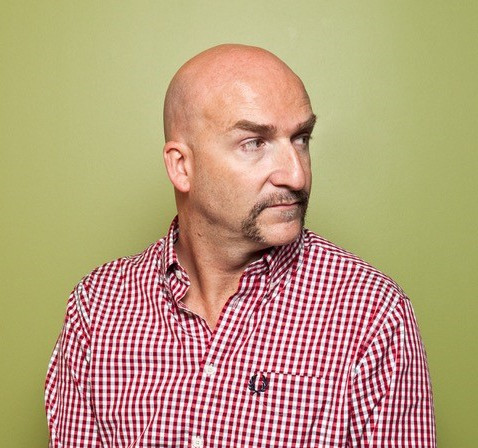
Carl W. Jones
Carl W. Jones is Senior Lecturer at the Westminster School of Media and Communication, research member of the Communication and Media Research Institute and a PhD candidate at the Royal College of Art in London. With a rich experience in marketing and advertising, he is now undertaking academic teaching and research on discrimination in advertising.
Please take a look at these four Mexican advertisements, and think about what is not there:
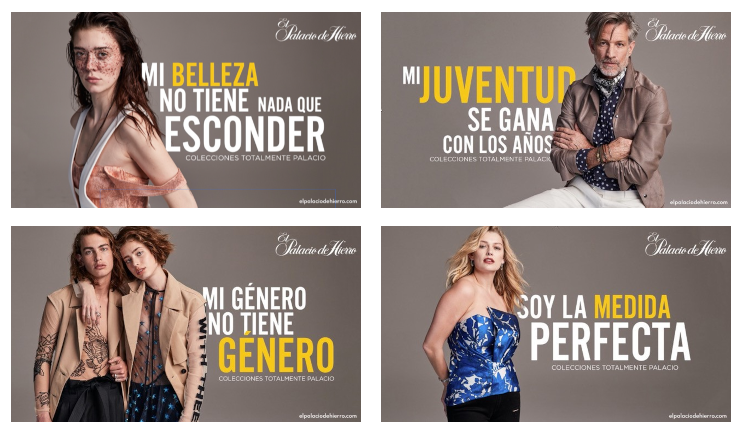
In a country like Mexico where 90% of the citizens are people of colour (POC) I ask why are indigenous or POC not appearing in these advertisements, or in the hundreds created every day in the metropolis of Mexico City? What is not shown is important, as it is a form of erasure, a way to forget certain peoples.
When I first moved to Mexico to work in the advertising industry in the 1990’s, my title was Creative Art Director and I couldn’t help but wonder why the people I saw on the street were not shown in the advertising, which featured what would be considered to a Mexican audience as mostly models with European features such as lighter skin. As part of my job, I had to recommend actors and models to appear in the advertisements and I would pick people of colour who reflected what I saw on the streets of Mexico. However, my clients would usually select models that appeared like a stereotypical European with lighter hair and eyes, even though those same clients were often what is termed in Mexico as ‘Moreno’ or mixed race that tend to have a darker skin tone and dark eyes.
After 20 years working in the practice of advertising I switched to academia and decided to investigate racism and decolonial theory for my PhD by practice. My research revealed that many advertisements contain two meanings (Jones 2015). One that the brand wants consumers to see and the secondary messages that re-enforce colonial concepts such as race, class and gender (Jones 2018). Therefore, I propose that advertising is a tool used by the ruling class in order to colonize.
For over 100 years western advertising agencies have been invading developing countries and promoting their clients’ brands through the appropriation of cultural codes and signs, that are re-interpreted, in order to seek authenticity with both the consumers and what Marx called ‘the ruling class.’ The spectacle of Advertising is part of mass media and encourages consumerism. French theorist Guy Debord in his book Society of the Spectacle (Debord 1995) defines The spectacle as everything “that once was directly lived has become mere representation” (thesis 1) and this representation can be defined as the ‘mass media’ (thesis 24).
In 1957, Debord founded the Situationists International (SI) which was made up of “avant-guard groups” (Knabb. ix) through an alliance with the mostly Paris based organization called Lettrist International (LI) merging with other vanguard organizations from Germany, England, and Scandinavia. (Debord 1992, p. 6). The S.I. produced the journal Internationale Situationniste and its first 200 copies were made available in 1958 with Debord as editor. The journal criticised popular culture through words and images.
The Situationists International (S.I.) dissolved in 1972 but their work inspired various writers, artists, and movements, including punk rock whose leader was Malcom Maclaren and this work often critiqued the ruling classes, or ‘peoples in power’ through the method of detournement. The advertising industry has also been directly challenged by the Canadian magazine Adbusters, through subvertisments, that make fun of commodity culture and capitalism. Subvertising can be described as “the production and dissemination of anti-ads that deflect Madison Avenue’s attempts to turn the consumer’s attention in a given direction, is a ubiquitous form of jamming. Often, it takes the form of “sniping” — illegal, late-night sneak attacks on public space by operatives armed with posters, brushes, and buckets of wheatpaste.” (Derry 1993). The world famous academic, book author and semiotician Umberto Echo claimed that in order to disrupt the mainstream, and keep control of the communication we need as a strategic solution, “to employ a guerrilla solution.” (Eco 1983, p. 11).
These are the main theories and methods that I employ to decode signs, including symbols which are then appropriated to ‘jam’ messaging through a weaponized advertising campaign. The rationale of this semiotic framework is to investigate if and how can advertising can be decolonized.
To accomplish this, I created seven different posters and placed them in sites close to where advertising agencies and their clients are located (Fig 5) in Mexico City. The name of the campaign is Racismo Neon (Neon racism) and the text printed on the posters is based on the literature review investigation. In total 4,000 posters were printed.

The Spanish language headlines translated into English are:
- If advertising reflects society, then advertising is racist.
- Whites are 10% of the population but are in 70% of the ads
- If Morenos are 80% of the population, why are we not in 80% of the ads?
- Advertising only reflects indigenous culture in charity ads
- “Consumers dream of being white even though they are brown”
- Why do ads favour white models and the American lifestyle?
- “I want blue eyes so I will buy these potato crips”
An important part of my research practice involves broadcasting on social media. I use social media to create a social transformation within the advertising community through an online conversation on how to decolonise Mexican advertising. Therefore, I created Racismo Neon social media pages on Twitter, Facebook and Instagram. To inspire online discussion, I took photographs of the posters in-situ, to post as content on social media along with the hashtag #racismoneon. If the targeted consumer did not walk past the posters on the street, then they could still see them in the social media posts.
After creating the social media conversation, I am now analysing it through Social Listening and content analysis of the conversation on social media and in the press. My objectives are to see if the Mexican advertising community agrees whether there is an issue with racism in advertising and search for solutions. Already a consensus seems to be crystalizing that there is such a problem. In this case, analysis of the online conversation will produce solutions.
Social media is a tool that can be used to both instigate racism and assist in decolonizing advertising. Through weaponizing advertising and going out to the very people who create messages, my research through practice has generated a conversation on social media, with the objective of inspiring a social transformation within the community. I believe that social media can be applied both as a negative, and positive tool. As a Negative tool it can be used as a method of control to spread disinformation. However, as a positive tool it can also be appropriated to generate a wide discussion with specific publics, and search for community-based solutions. My research through practice is not solving the process of decolonization, but is making a small contribution through the theoretical technique of subversive strategies.
References
Debord, G. (1992). Society of the spectacle and other films. London: Rebel press.
Debord, G. (1995). The society of the spectacle. New York: Zone books.
Dery, M. (2010 [1993]). Culture Jamming: Hacking, Slashing, and Sniping in the Empire of Signs. (last accessed November 25th 2022). This essay originally appeared in 1993, as Pamphlet #25 in the Open Magazine Pamphlet Series.
Eco, U. (1986). “Towards a Semiological Guerrilla Warfare.” In Travels in Hyperreality. New York: Harcourt Brace Jovanovich, pp. 138, 143, 144.
Jones, C. W. (2015). Ads send out more than the clients’ message. (last accessed April 2, 2021).
Jones, C. W. (2016). “Advertising tools and techniques appropriated to construct the global brand Mr. Clean”. In Proceedings of the world congress of the IASS/AIS 12th WCS Sofia 2014 New Semiotics. Sofia: NBU press. DOI: 10.24308/iass-2014-062.
Jones, C. W. (2018). Racism and Classism in Mexican Advertising.In Olteanu, A., Stables, A., Borţun, D. (eds) Meanings & Co. Numanities – Arts and Humanities in Progress, vol 6. Cham: Springer. https://doi.org/10.1007/978-3-319-91986-7_13.
Jones, Carl (2019) Personal Branding using advertising tools and techniques a case study. In Zantides, E. (ed.) Semiotics and Visual Communication III: Cultures of Branding, Newcastle upon Tyne: Cambridge Scholars.
Knabb, Kenn (2006) Situationist international anthology. revised and expanded edition. Berkley, Ca.: Bureau of public secrets.
Figures
Fig 1-4: “MI BELLEZA NO TIENE NADA QUE ESCONDER” / “MI JUVENTUD SE GANA CON LOS AÑOS” / “MI GÉNERO NO TIENE GÉNERO” / “SOY LA MEDIDA PERFECTA” Billboards. Espectacular. 2018. Client: Palacio de Hierro. Mexico City. Palacio Billboard broadcast in Mexico City, and other cities where Palacio De Hierro has stores. First air date TBC 6.3.2018. Images obtained from news article. Source. 03/03/2018. Excelsior. https://www.excelsior.com.mx/de-la-red/2018/03/03/1223987 (last accessed 23 Nov. 2022), see also: https://www.sdpnoticias.com/estilo-de-vida/2018/03/06/el-palacio-de-hierro-lanza-campana-que-busca-romper-con-estereotipos (last accessed April 2nd 2021).
Fig 5: Racismo Neon posters in the streets of Mexico City. Photo Carl Jones (authors own) July 2022.
Proposed citation: Jones, Carl W. (2022). Decolonising Advertising through content creation, broadcast on social media, to inspire social transformation. https://khk.rwth-aachen.de/2022/12/02/5074/5074
Biosemiotic Erasmus adventures
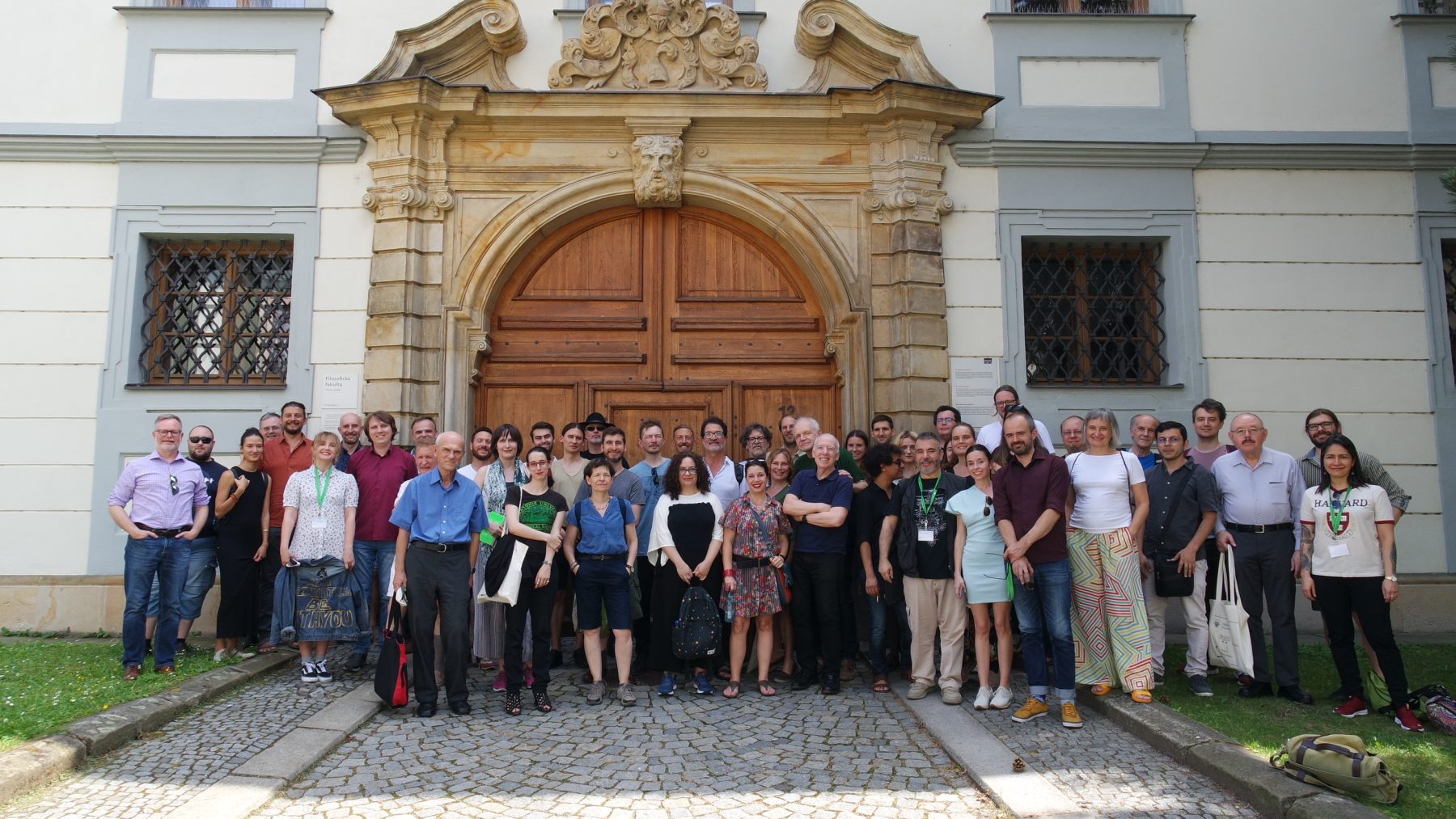
CHIARA SCHUMANN AND JULE JANßEN
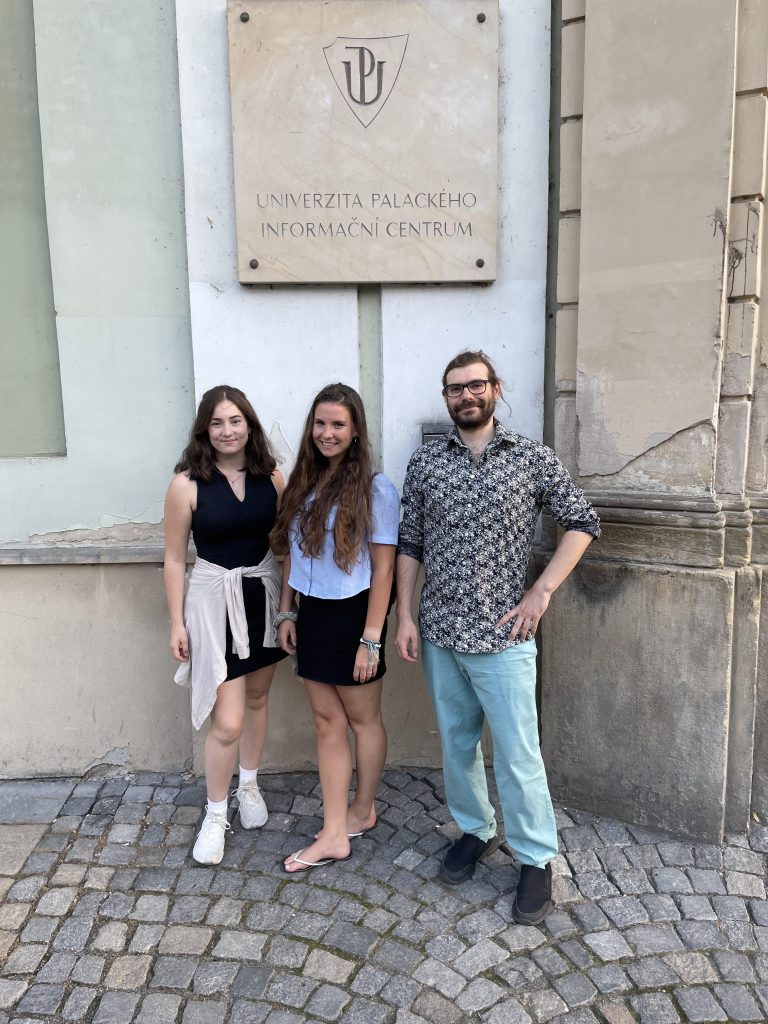
As the first RWTH Aachen University students benefitting from the new Erasmus Blended Intensive Program (BIP) funding scheme, we wrote this text to convey our personal experiences to academics and university managers but especially to other students, who might be thinking of using Erasmus BIP.
We used this type of funding to participate to the 22nd Gathering in Biosemiotics, in the Czech Republic. We very much enjoyed attending this conference, organized by the International Society for Biosemiotics. Not only did this open new professional horizons for us, but it was also a very fun experience. Attending this event by using Erasmus funds was made possible by Dr. Ľudmila Lacková and her team, who arranged such a funding program at this conference, which was hosted at Palacky University Olomouc from June 25th to July 1st, 2022. We would like to thank Dr. Alin Olteanu, who facilitated our participation to the conference from the RWTH Aachen end. We met Alin through a BA introductory seminar to semiotics that he teaches, part of an interdisciplinary module at our faculty. Through this seminar, we became fascinated with semiotics.

Chiara Schumann & Jule Janßen
Chiara Schumann and Jule Janßen are both B.A. students in Linguistics and Literary Sciences at RWTH Aachen University.
Chiara Schumann is interested in the interdisciplinary fields Bio- and Zoosemiotics as well as Neuro- and Psycholinguistics. In her B.A. work, she considers animal behaviour data in light of concepts from cognitive linguistics and Charles S. Peirce’s semiotics. In this way, she aims to contribute to the state-of-the-art in animal cognition.
Jule Janßen is interested in semiotic approaches to notions of linguistics, among which, primarily, mental lexicon and language evolution. She aims to explore grounding these concepts in ontological discussions on the relation between mind and body. Given her interest in semiotics, she intends to work further on the interface between linguistics, cognitive science and semiotics. She hopes to contribute to the interdisciplinary study of language development.
The 22nd International Gathering in Biosemiotics (2022) comprised 65 talks, by renowned researchers in the field, some excavating in detail, others orbiting or framing the discipline’s colorful spectrum with multidisciplinary questions on the study of living systems. Hosted by Palacký University Olomouc in Czechia, the conference program was excellently organized by the Department of General Linguistics – Ľudmila Lacková, Claudio J. Rodríguez Higuera, Tyler J. Bennet and their colleagues. The entire conference was live-streamed on YouTube. It is accessible on the channel “Biosemiotics Palacký University in Olomouc”.
Biosemiotics bridges natural sciences and humanities by approaching classical issues of biology (for example, DNA replication or various modes of intra- and interspecific animal communication) from a reflective point of view, in the interrogation of sign exchanges within and between organisms. Expanding the investigations of pioneers like Thomas A. Sebeok, Jesper Hoffmeyer and John Deely, the semiotic study of biological organisms generally draws on basic questions like: How do cells of flora and fauna create meaning? What stimuli are engaged in species specific perception? How does biosemiosis contribute to the understanding of human and non-human cognition and what should the study of life encompass, theoretically and practically?
The Gathering started with two pre-conference workshops that particularly addressed students and early career researchers. Prof. Dr. Elize Bisanz, who holds the Charles Sanders Peirce Interdisciplinary Chair at Texas Tech University hosted the workshop “The Future of the Humachine”, with a digital humanities focus. This covered topics such as the impact of AI and digitalization both on the biopshere as well as on cultures and societies. Discussions led to questions on whether we can implement in machines an ability to experience meaning, in a Peircean semiotic construal. To shed light on the diversity and variation of sign systems in the human world, graduate and undergraduate students were asked to present an artistic object of their choice analyse their subjective experience of it within the semiotic notion of meaning as triadic relation of ‘representamen’, ‘object’ and ‘interpretant’. As BA students, we were excited to speak in front of this impressive audience. Debates emerged based on our inputs and the feedback we received was kind and constructive.
Doc. RNDr. Anton Markoš and Dr. Jana Švorcová (Charles University in Prague) led the second workshop, “Life as a Semiotic Category”, which addressed the work and heritage of John Deely. This started with the consideration of ‘cellular closure’ and ‘mutual communication within cell ensembles’. Participants were led through a reflection on the remarkable fact that the minimal equipment of prokaryotes, say mouth, flagellum, organs, and a protective skin turned out so phylogenetically irreducible and effective that these characteristics still determine the appearance of higher animals and their immanent semiotic processes.
Honoured with the dreamlike location of a baroque chapel, the Gathering started on Monday with warm welcoming words by Donald Favareau and Kalevi Kull, veterans of biosemiotics. Claudio Rodríguez Higuera opened the first panel of talks, followed by other very important scholars in biosemiotics, Morten Tønnessen and Timo Maran. Thanks to the diverse educational backgrounds of the presenters, each day’s panels were filled with the most thought-provoking talks, from sign exchange on the level of the genetic code and cells over embodiment, endo- and exo-semiosis, Uexküll’s notion of Umwelt and Peirce’s sign theory and up to metaphysical approaches to the universe and God concepts. While the speakers of the first day provided general, though highly inspiring and sophisticated overviews of topics like ‘zoosemiotics’, ‘organism intersubjectivity’, ‘iconicity’ and ‘cognitive metaphoric approach to the genetic code’, on the next days presentations zoomed in on more specific and detailed issues.
Here, we briefly overview a few among the many intriguing talks. To begin with, we highlight Josh Bacigalupi’s presentation of his heuristic model of semiogenesis, inspired from Gilbert Simondon’s theory of individuation. This aims to offer a better and updated theoretical support for Peirce’s notion of sign as triadic. Coming from an interdisciplinary background of environmental sciences, chemistry and architecture, his approach is located at the interface between design and the maintenance of vitality in life systems. We found it an inspiring and creative approach.
Anton Markoš and Jana Švorcová discussed symbiogenetic dependency across species, in a talk titled “we, the cyborg”. Their argument starts from a criticism of one-way construals of relationships in the biosphere: species are interdependent as they are suppliers in some relationships and receivers in others. With reference to the notion of a cyborg, they lay focus on a collaborative rather than a competitive model and thus draw attention on collaboration as a principle that is essential not only for evolution, but also, more specifically, for scientific work.
Dr. Jamin Pelkey held a captivating talk on “analogy in evolution: a Peircean biosemiotic perspective”. More than convincing, the talk offered an inspiring and original language view on development. Jamin Pelkey showcased the language development of his own daughter, with examples of her linguistic expressions. By showing how his daughter went from calling her long green building block a ‘/kini/’ based on the similarity to a zucchini to naming her red and blue blocks ‘red’ and ‘blue’ ‘/kinis/’, but not her yellow block (named ‘/nænə/’ for banana), he demonstrated the importance of iconicity and analogy, automation and diagrammatization in language evolution.
We also highly appreciated the presentation of Yogi Hendlin and Matthew Slayton and of Martin Švantner. These presentations on “the musical turn in biosemiotics – an expressivist model of communication” and, respectively, “missing simple musicalities: the incomplete nature of music”, innovatively drew on (zoo)musicological studies to discuss communication, broadly. The co-development and particularly shared interpretable quality of music and language in the biosphere led Hendlin and Slayton to uncover musical qualities in some iconic and aesthetic aspects of meaning-making in general. Švantner explored the consequences of imputing music with expressions of a “simple language”.
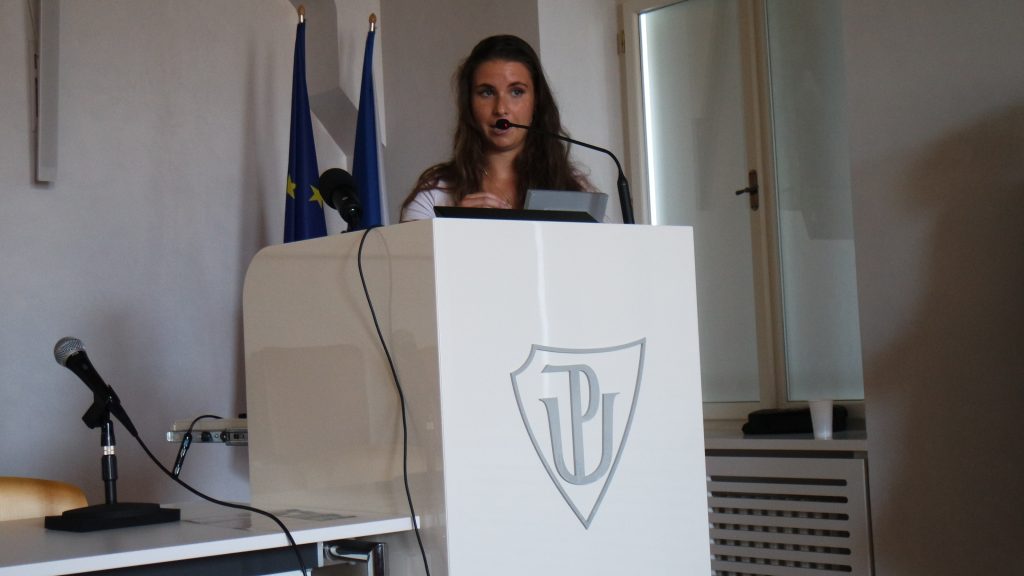
As we see it, most talks revolved either around the topic of endosemiosis (semiosis taking place within living beings, i.e. message exchange among cellular organelles, cells, tissues, organs and organ systems) or around ethical and philosophical meta-discussions about general semiotic theories and frameworks. On the fourth day of the Gathering, Alin and Chiara presented their papers on “Umwelt as Embodied Mediatization: a Biosemiotic Approach to Technology” and, respectively, “Image Schemas and Behavioral Deception in American Eastern Grey Squirrels – a Zoosemiotic Approach”. Chiara feels that presenting her work in this setting was a very enriching learning experience. As a study using theories both from semiotics and cognitive linguistics to investigate the rodent’s intraspecific intentional deceptive communication, retrospectively, Chiara thinks of her presentation as part of the few ones that focused on exosemiosis and practical, illustrative applications of the Umwelt-principle, the ‘pluralistic approach’ and, implicitly, non-human intersubjectivity. Hopefully, this contributes to sedimenting a non-anthropocentic perspective on non-human animals’ subjective and embodied construction of environments, which uniquely correspond to bodily- and cognitive apparata. From this perspective, it is misleading to deem some types of perception as qualitatively superior to others. Image schemas and the correlation of object, representamen and interpretant, as defined by Peirce, were used to describe the wild squirrels’ deceptive behavior in a systematic manner. Addressing heteroperception, theory of mind, metasemiosis and possible worlds led to various interesting questions and suggestions from the audience. By receiving positive feedback and constructive criticism, Chiara was enabled to reflect upon her future work. We both learned from well-established scholars, who were always eager to help and discuss any issues we raised. Speaking in front of the great minds of this discipline is a worthwhile challenge. This Erasmus experience will surely stay with us, further guiding our personal and professional development. Not only did this trip determine Chiara to write a BA thesis within the field of biosemiotics, but it also encouraged us both to think beyond our study program, broadening the horizon of feasible possibilities for us in the academic environment.
Coffee and lunch breaks in-between talks were most enjoyable, allowing for networking and pursuing conversations on specific interests. The conference had a rich social program, involving visiting the nearby Bouzov Castle, a soirée in the university’s gardens and a celebration of the 70th anniversary of biosemiotics professor Kalevi Kull. On top of the interesting academic program, such social events made this Erasmus experience surpass our expectations.
In the friendly atmosphere of the conference, together with other participants, we tried several local restaurants and pubs. We learned that academic conferences have two inseparable parts: listening to hours of academic presentations is made easy and even more interesting by personally getting to know and spending time with the scholars themselves. Meeting the persons behind the literature we studied was a delightful experience. Everyone was respectful, friendly, open-minded, fun and, unlike how students might perceive senior academics at times, down-to-earth. Casually chatting with your favourite scholars about their presentations, their latest research, their points of view on animal ethics or even personal interests seemed hardly possible until attending this conference. We highly enjoyed all of these dialogues. Group talks went from sophisticated discussions about semiotics to everyday matters. Beside other wonderful talks, we had the pleasure to learn from great minds like Timo Maran. Chiara sat two times for a whole hour, next to a beer, talking with Timo Maran about research interests, future plans and even their pets.
From professors to PhD scholars, many scholars kindly offered to help us with literature and subject-specific questions. Having been encouraged to develop and submit her paper to the journal Biosemiotics and being asked to collaborate, Chiara had the confirmation that she found an important topic to focus on. This reassured her desire to further engage with bio- and especially zoo-semiotic research. It was nice to see how a large number of young participants was welcomed at this Gathering. Becoming part of this community is a beautiful experience. While in class it is difficult to find like-minded colleagues, with whom to debate specific arguments, at a conference all attendees are passionate about the topic. Kalevi Kull emphasized the importance to overcome bad competition in science and advised: “[W]hen we think about what academic life is, what its meaning is, I strongly think that we can formulate – and that will be the most right formulation of academic work – helping each other in understanding”. In him and in many other scholars we met at this conference, we find excellent examples to follow, showing us that academic development needs practicing care and affection. We hope that we will be able to apply and give back what we learned at the Gathering.
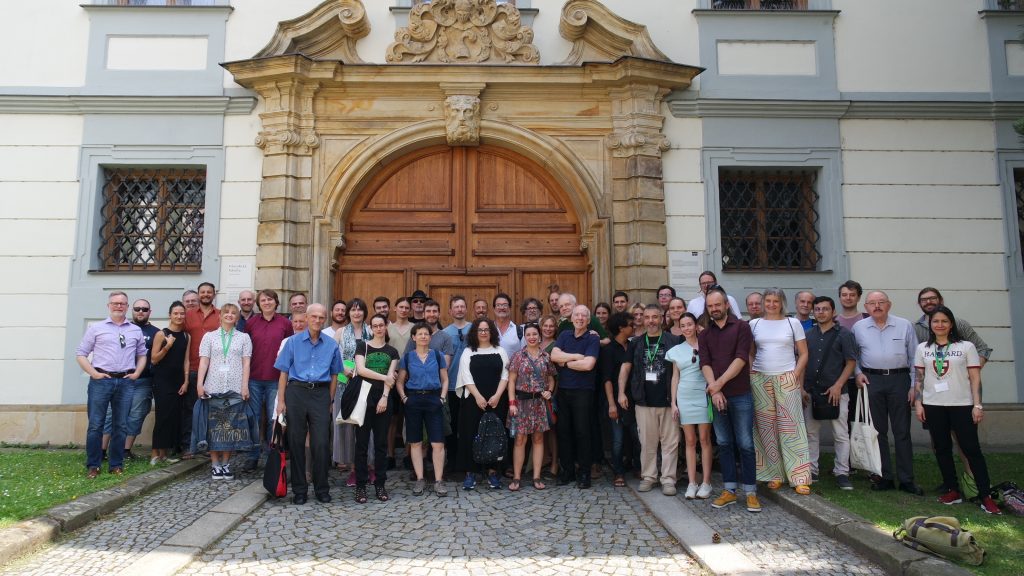
proposed citation: Schumann, Chiara and Jule Janßen (2022). Biosemiotic Erasmus Adventures. https://khk.rwth-aachen.de/2022/07/25/4290/4290
The Notebook pt. 2: “I liked the idea of carrying my research in just one bag”

Academic writing is a basic practice that does not start in writing up one’s research results for publishing. Right from the start of an idea for a research project, researchers are noting down things: thoughts, questions, observations, ideas. Let’s have a look at the often neglected but very central object that inhabits these very first materializations of research ideas: the notebook. How does the notebook of a researcher look like? How do practices of note taking change in the digital age? I asked some of the fellows at the Käte Hamburger Kolleg: Cultures of Research (c:o/re) about their habits of note taking.

Markus Pantsar
Markus Pantsar is a philosopher of mathematics and artificial intelligence at the University of Helsinki, Finland. As a senior grant researcher, he worked on the epistemology of mathematics and will continue to do so with a focus on arithmetic and geometrical cognition with a funding by the Finnish Cultural Foundation that starts in autumn 2022. In the meantime, Markus tackles questions of complexity, human cognition and intelligence with regard to the development of artificial intelligence, simulation and machine learning during his fellowship at c:o/re.
Stefanie Haupt: Markus, what is the most recent thing that you noted down in your notebook?
Markus Pantsar: [thinks for a short moment and checks his notebook] It was something I wrote down from last week’s workshop. I usually take notes only sparingly. They are mostly personal reminders of things that inspire me when listening to talks – for example names or books and papers.
Stefanie: Your notes are handwritten but on a digital devise, how does that work for you?
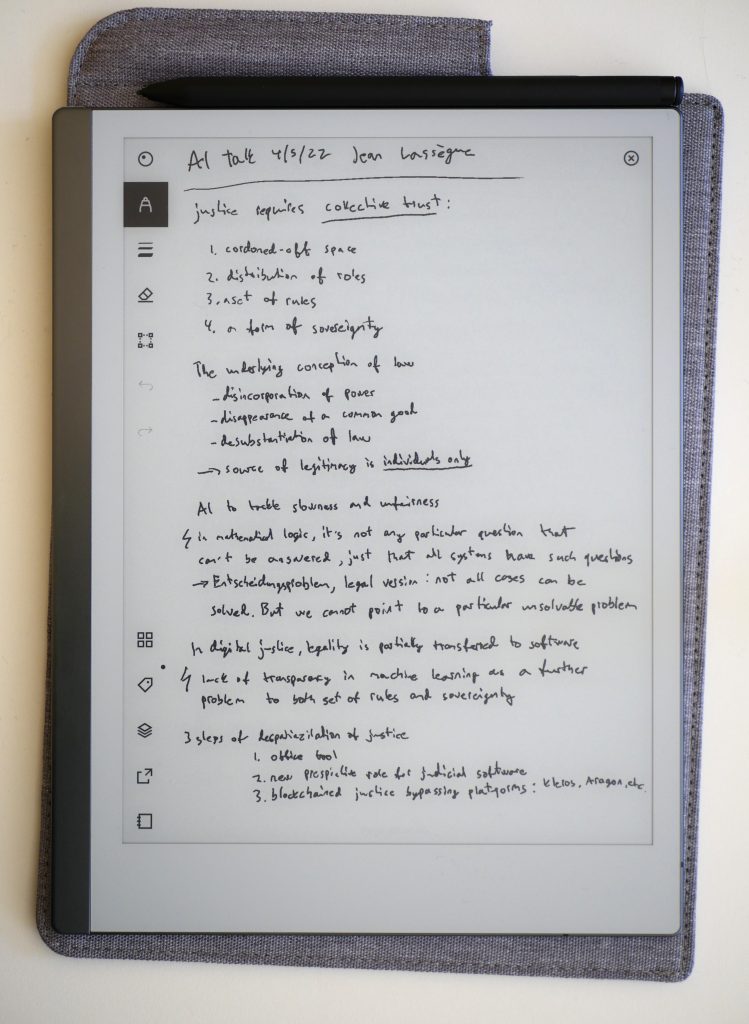
Markus: It works fine. I can either convert the pages to images or, and this is what I use mostly, the built-in AI transforms my handwriting to searchable type-written text. It just needs some editing afterwards. The software does not recognize, for example, names so easily. But otherwise, it works well for me.
Stefanie: And what happens after you convert the notes?
Markus: The software turns them into pdf-documents that I keep in different folders, for example, for conferences I attended. I also have a folder for my fellowship here in Aachen. Typically, I remember better where I heard interesting thoughts than when I heard them. Therefore, my folders follow a structure based on places rather than on pure chronology. I save everything in the cloud because I can see myself pouring coffee over my stuff [smiles].
Stefanie: I am looking at your desk right now and I see hardly any paper. When did you switch to the digital? Was it a conscious decision?
Markus: Yes, definitely. For me this is a very recent development. I bought this notebook in preparation for my fellowship in Aachen. I wanted something like this for a long time: a devise to write and to read digital papers and books on. Previously, I used to print articles and write into paper notebooks and they kept piling up in the bookshelf. But as a researcher you often have to move and switch places. I liked the idea of carrying my research in just one bag.
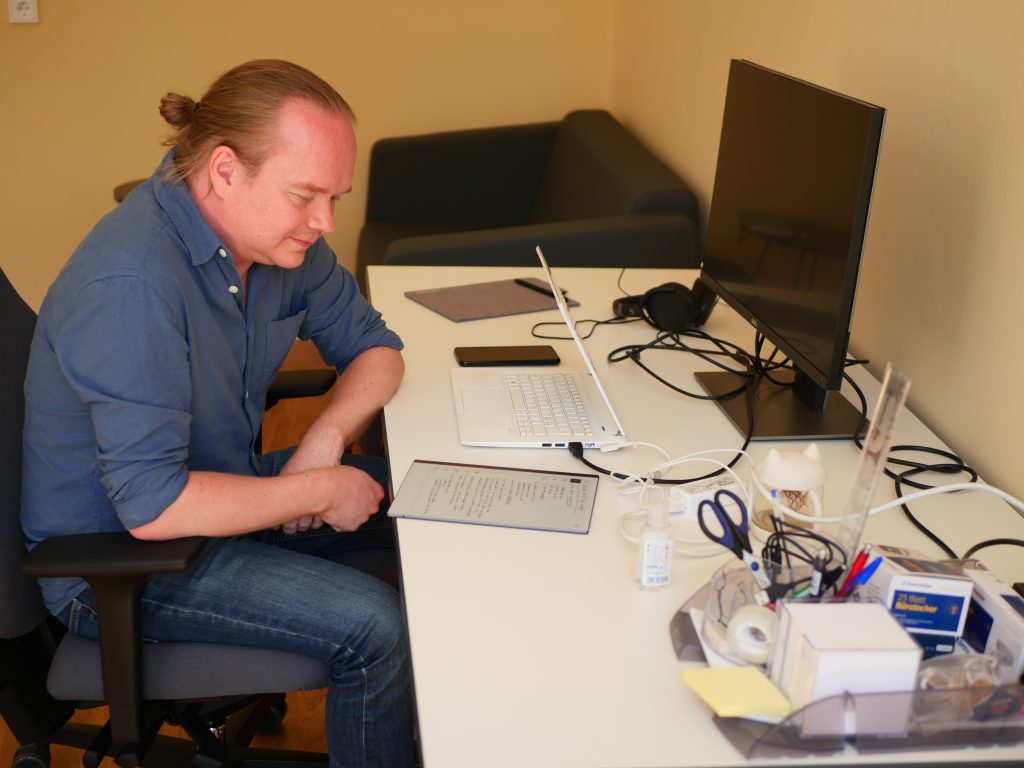
Stefanie: This is close to the ideal of the paperless office, which is also very ecological. Do you also see disadvantages compared to the analogue notebook?
Markus: Well, regarding the ecological factor you need to consider the production of such an electronic devise. Disadvantages – there aren’t many: The notebook won’t transform special symbols that the software does not recognize. For example, I use a kind of flash-symbol to mark points of disagreement with the arguments of others. Also, the notebook does not display colours, so whenever I read a paper and there is a coloured image, for example a graphic depiction of different activation areas in the brain, I am missing some of the information there. One disadvantage is also that for such a simple machine, it is still very expensive. It does not have internet access, aside from the cloud function for the files – but this is something I appreciate, actually: I can sit on the couch reading and not get distracted.
Stefanie: Did switching to digital change your practice of note taking somehow?
Markus: Now that we are talking about it, I would say: Yes, it did! Unlike with analogue notes, I have to go through the digital notes again to edit them after converting the text. This is necessary to find names and other keywords via the search function later. It has already become a kind of routine for me. And it also often prompts me to write down more about what I heard and inspires me to think deeper about it. I would say that now I am working more with my notes than before. But there is also a qualitative difference, in that my notes end up being more polished and easier to apply. I don’t think I will switch back to the analogue.
Stefanie: Thank you very much, Markus, for a short glimpse into your notebook!
The Notebook pt. 1: Taking Notes – “it’s a learned skill”

Producing, sharing, questioning, and contesting knowledge – in academia this is done mostly by writing and publishing papers. To make themselves heard in the academic world and to take part in scholarly debates, researchers have to write down their thoughts, ideas and suggestions to research problems and questions. Writing is an essential research practice. But rather than focussing on the finished product, the well composed text, edited, proof-read multiple times, peer reviewed, and published in a (most desirably high-impact) journal, let’s take a few steps back to the very beginning of a research project. What precedes even the “shitty first draft” of a written piece? I would like to look at the threshold where thoughts “materialize” and are written down for the first time. Let’s do this by shedding light on a particular object that is often overlooked when it comes to academic writing: the notebook. I interviewed some of the fellows at the Käte Hamburger Kolleg: Cultures of Research (c:o/re) about their note taking.
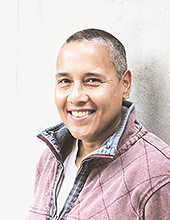
Catharina Landström
Catharina is an Associate Professor of Science and Technology Studies at Chalmers University in Gothenburg, Sweden. Prior to that, she was as senior researcher at the School of Geography and the Environment at the University of Oxford, England. Right from the start of her professional carrier, she has conducted a lot of field work, for example on water challenges such as flooding, draughts and water quality. At c:o/re she explores how environmental scientists present and convey results from- and tools of computer simulation modelling for decision making processes
Stefanie Haupt: Catharina, when I saw you with your notebook during the c:o/re Lunch Talks it really fascinated me how neatly you were taking notes. Your notebook has lined pages in an A4 format. Do you prefer a certain type of notebook?

Catharina Landström: I do take notes on any sort paper I can get hold of! Normally, I just use what I can find: binders that came as a kind of gift at conferences etc., or I use whatever I can find in the storage of the university. I prefer writing on lined paper. Squared paper does not really work for me. And blank paper – I get paralyzed when the page is empty! Papers with a column on the left side are quite nice for making comments. I like taking notes in wire bound notebooks. Then I can easily take out the page because, depending on the topics I am working on, I collect the pages on different piles. I also have different notebooks for different topics and tasks, for example for the different PhD projects that I supervise. The notebook you saw in the Lunch Talk is my c:o/re notebook.

Stefanie: When did you start taking notes and in which situations do you use your notebook? You did a lot of field work. Did you also bring a notebook when you were out in the field?
Catharina: Right from the beginning of my studies I took notes. But the way I do changed much over the time: I remember in my PhD project while working in the field, I took so many notes, I sometimes could not make sense out of them afterwards. The field is a difficult place for taking notes. It is a really stressful work. Everything that happens “passes” through you. In the field you are the tool. And notes are more than notes. So, I tried to capture everything. Today, I take less notes but they are more precise. It is really a learned skill.
Stefanie: So, what is it that you note down?
Catharina: Thoughts. Thoughts of others, my own thoughts while listening to a talk for example. My notes help me to remember better. For example, I note down what I discuss with my PhD students. I also write down ideas for project proposals. By going through them, my notes help me to further develop ideas.
Stefanie: Did you develop a kind of private system? Like a colour code? And how do you further process your notes?
Catharina: A colour code would require having a fixed set of colour pens with me all the time – so, no. But when I listen to talks and note down what I hear, I distinguish the thoughts of others from my own by putting mine in squared brackets. Questions that arise come in round brackets. The notes I take are only for myself. I switch to the digital when I want to further develop ideas for myself or when I want to share them with somebody else.
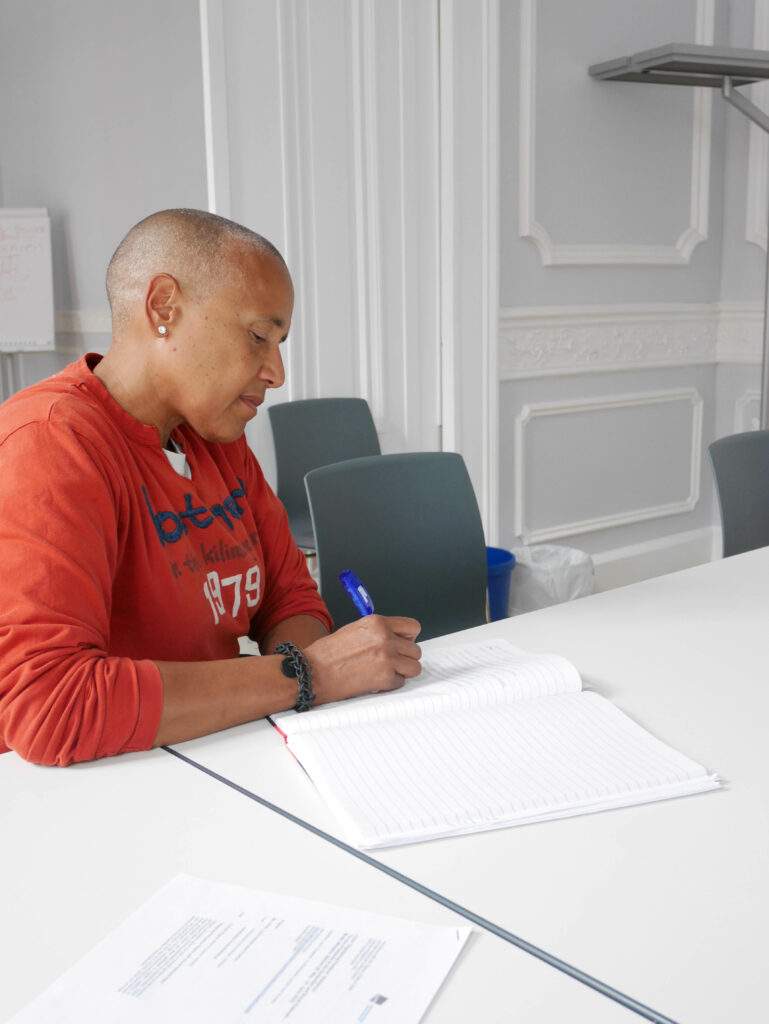
Stefanie: Do you keep your notebooks?
Catharina: I keep them for a while. Everything is time limited, you know. Then comes the time when you can either store your notebooks in a box in the attic or throw them away. Once I suggested to a friend to throw away the notes she took during an interview project in the 90s. She was really irritated by this suggestion.
Stefanie: You told me that you were wondering at some point if you might also switch to the digital for note-taking, too.
Catharina: Oh, I did. Everybody brings their (laptop)notebook to academic discussions today. I tried that for a while, too. But I noticed that I never go back to look at digital notes again [Catharina laughs]. I don’t know what it is, maybe it is the paper, the feel, the way you can browse through the pages. It has a different quality somehow.
Stefanie: Thank you, Catharina, for your time!
Introduction to the concepts of Open Science, Responsible Research and Innovation and Anticipatory Governance
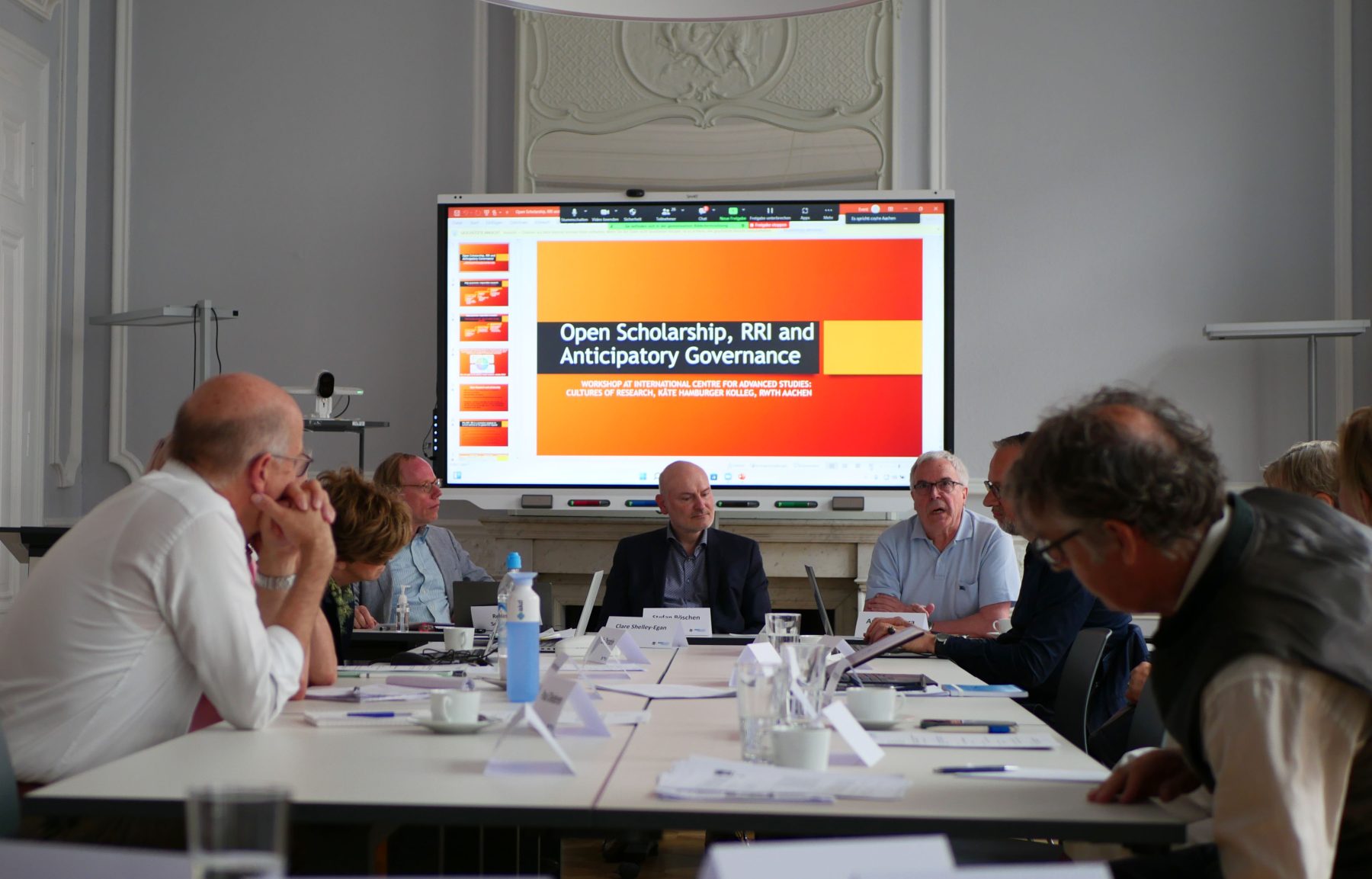
RENÉ VON SCHOMBERG AND ANDONI IBARRA
Responsible Research and lnnovation (RRI) has become increasingly important since it was introduced as a cross cutting issue under the European Union (EU) Framework Programme for Research and Innovation “Horizon Europe” (2014-2020). Subsequently, it became an operational objective of the strategic plan for “Horizon Europe (2021-2027)”, the new EU Framework Programme for Research and Innovation. ln EU member states, there are also various initiatives supporting RRI, notably under schemes of national research councils (the United Kingdom, Norway, and the Netherlands, among others). The concept also resonated outside the EU, notably in the United States, and in China it became part of the national five-year plan for Science, Technology and Innovation.
However, there are a variety of approaches as for how it should be implemented. Scholars provide a variety of perspectives and assessments of what RRI need to address. However, all scholars generally share the notion that RRI requires a form of governance that will direct or re-direct innovation towards socially desirable outcomes. This initial definition that Von Schomberg provided in 2011 captures the commonalities of the field:
Responsible Research and Innovation is a transparent, interactive process by which societal actors and innovators become mutually responsive to each other with a view to the (ethical) acceptability, sustainability and societal desirability of the innovation process and its marketable products (in order to allow a proper embedding of scientific and technological advances in our society).
This definition was not proposed as an end-result but as a starting point for an ever-growing field of research and innovation actions. The definition was put forward, first, to highlight that dominant public policies only negatively select science and technology-related options, notably by the management of their risks. According to the still dominant ideology, all innovation will contribute to common prosperity regardless of its nature. The notion of responsible research and innovation makes a radical break with such an ideology. Furthermore, this ideology tells us that innovations cannot be managed or be given a particular direction. Also on this front, the notion of responsible innovation breaks with this ideology and puts the power for a socially desirable change through innovations into the hands of stakeholders and engaged citizens. However, these stakeholders have to become, or be incentivized or even enforced to become, mutually responsive to each other in terms of social commitments to such change.
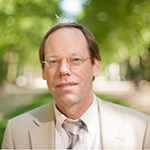
René von Schomberg
René is Guest Professor at the Technical University of Darmstadt, Germany. He was a European Union Fellow and Guest-Professor at George Mason University, USA, from 2007 to 2008 and has been with the European Commission from 1998 to January 2022. In his research project as a senior fellow at c:o/re, he focusses on the values of “openness” and “responsibility” in science policy.
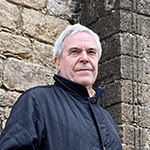
Andoni Ibarra
Andoni is Professor of Philosophy of Science at the University of the Basque Country (UPV/EHU). He is also the Principal Investigator of PRAXIS Research Group, the founder of the Miguel Sánchez-Mazas Chair. As a senior researcher at c:o/re, he is developing an anticipatory governance framework aimed at assessing and guiding the implementation of responsible anticipatory practices in research and innovation in the field of nanotechnologies.
Responsible Research and Innovation (RRI) imposes normative requirements on research and innovation processes resembling three successive steps of an incremental higher ambition with distinct features. The distinct features reflect the normative requirements of firstly, credible research (through among others ‘codes of conduct’ and standards for scientific integrity), secondly responsive research (by opening up science to societal demands), and finally responsible research (which includes the anticipation on socially desirable outcomes) for the research dimension. Equally distinct features reflect the requirements of credible innovation, responsive innovation, and responsible innovation (Von Schomberg, 2019).


For each of these steps, a framework for good practice is needed. The contributions to the workshop “Open Scholarship, Responsible Innovation and Anticipatory Governance” that took place on June 29-30, 2022, at the Käte Hamburger Kolleg: Cultures of Research, can be seen as attempts to contribute to these good practices for a single step or for multiple steps. First, the creation of knowledge in science underlies distinct universalizable codes for ‘good’ research conduct, enabling a global research practice that is virtually independent of cultural and national constraints. As the previous director of the US National Science Foundation Subra Suresh put it: ‘Good science anywhere is good for science everywhere’. The issue of ‘what is good science?’ can be seen as purely internal matter of the scientific community. Indeed, it has always been scholarly societies or academies of science who have tackled this issue of credible research, which arguably also constitutes the most basic requirement of RRI.
However, we should not forget these scholarly societies and other scientific institutions only engaged with the internal issue of good scientific conduct and scientific integrity because of external societal pressure and clear ethical challenges. That this is an issue which is far from settled.
Yet, Responsible Research and Innovation with within its dimension of ‘open scholarship’ has put additional pressure on revising or extending the normative requirements of this first step for RRI governance, namely credible research and thereby calling for revision of existing codes of conduct for good science particular with a view on achieving credible, reproduceable and re-usable data, all necessary to enhance science as such.
Open research and scholarship can be defined as ‘sharing knowledge and data as early as possible with all relevant knowledge actors‘ (Von Schomberg, 2019). Open research and scholarship (in the research policy-making context often simply referred to as ‘open science’) is operationalised by researchers who use, re-use and produce open research outputs such publications, software and data and who engage in open collaboration with other scientists, as well as seek, whenever appropriate for the subject matter of study, open collaboration with knowledge actors external to science such as industrial organisations, civil society organisations or public authorities.
During the Covid-19 pandemic, we have witnessed a change in the modus operandi of doing science as public authorities started to incentivize open science globally. This made it possible to deliver swiftly on vaccines. Without open science, the market introduction of these vaccines would have taken, under the usual circumstances of competitive and too closed forms of science, minimally a decade.
The research value ‘openness’ can be seen as a constitutional value for the scientific community as such. Open scientific discourse, the exchange of ideas and competing approaches is fundamental for the progress of modern science. ‘Openness’ is presupposed by the Mertonian norm ‘Communism’ (common ownership of scientific discoveries) and thus part of the ethos of science (Merton, 1942). However, the meaning of ‘openness’ is manifold and is dependent on the scientific discipline or the scientific mission in which it is embedded. With the emergence of Open Science, equally ethical issues concerning the limits to ‘openness’ in particular contexts become evident, such as the employment of sensitive data in security or biomedical fields.
Open research and scholarship manifest itself notably in the case of interdisciplinary scientific cooperation with a view on developing a socially desirable output as the case of Covid-19 demonstrated. Open research and scholarship have been incentivized with a view of making science more efficient (better sharing of resources), more reliable (better verification of research data) and making it more productive with a view on a socially desirable output (in this case a vaccine). Research virtues or norms have been phrased historically as a subset of general human virtues. From the Mertonian CUDOS norms (Merton,1942) to the codified principles of research integrity incorporated in the All European Academies’ European Code of Conduct for Research Integrity, norms or principles have been described as a fundament of a ‘good’ research practice. The ‘responsibility’ of the scientific community is then often described as an overarching duty to promote, manage, and monitor a research culture that is based on the scientific integrity of its members (ALLEA, 2017). Furthermore, research integrity does include a particular form of responsibility, namely the accountability for the whole internal process of science from idea to publication. The ‘implementation’ of scientific integrity is managed by self-regulation of the scientific community.
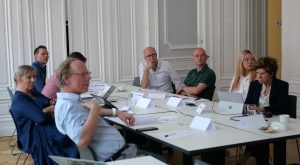
Traditionally the scientific community has stopped short of taking any form of responsibility for consequences and side-consequences of the societal use of scientific insights and technologies and its unpredictable societal impacts. The responsibility for those consequences has been ‘allocated’ to the political system. This division of responsibilities has become subject of intense debate, virtually since the whole period after Word War II. Intense debate on the risks of emerging technologies have led to the adoption of national laws and European directives on the risks, the quality and efficacy of products arising from the use of new technologies. Western societies have gained the capacity to indirectly govern emerging technologies, notably through its risk management and to outlaw specific undesirable outcomes, such as cloning human beings. Our institutions have thus governance structures in place to manage the risks of technologies such as nuclear technology, genetic or nanoengineering. However, we do not have established capacities to anticipate or direct science and innovation towards socially desirable outcomes such as vaccines or outcomes that underpin or make the transition towards sustainability possible. Responsible Research and Innovation (RRI) has emerged as response to this deficit in the governance of science and technology. RRI requires a form of governance that will either direct science towards socially desirable outcomes or manage innovation processes in such a way that those socially desirable outcomes are more likely to emerge (Von Schomberg 2019).
It is therefore desirable to develop further a governance framework which institutionalizes the organization of co-responsibility across the spheres of science, policy and society on a subject matter which require open science missions such as Covid-19. The institutionalization of co-responsibility requires a governance which goes beyond self-regulating mechanisms within science itself. There is a ‘responsibility’ for ‘organizing co-responsibility,’ shared by scientific, policy and societal actors. The institutionalization of this responsibility will have consequences for the way science is funded and organized, for example through policy and financial incentives to embark on socially relevant open research missions. For example, by means of co-creation and co-design of research agendas with scientific, policy and societal actors which are currently foreseen in the “Horizon Europe (2021-2027)” program. An important aspect is the governance of the research missions themselves. When open research missions are conducted to achieve a socially desirable objective, its governance and organization will significantly have to differ from research missions with a primary technological objective (for example: ‘putting a man on the moon’). In fact, the ultimate step to complete RRI with anticipatory governance is inherent for this type of mission-oriented research.
The governance of research of innovation based on a Framework of RRI thus requires credible research, open and responsive research and responsible research that anticipates socially desirable outcomes. This anticipation also presupposes that such research and innovation is inevitably value-driven as those values mark the desirability or undesirability of research and innovation outcomes.
The desirability of open scholarship is often motivated by the wish to achieve better scientific practices. However, RRI is more ambitious and represents an effort to drive research and innovation towards socially desirable outcomes. We, therefore, must address the question how we can define these outcomes, for example by the way we anticipate them. The employment of foresight is one of the few tools we have at our disposal, and possibly the most robust one. Broadly speaking, anticipation can be defined as an activity characterized by the use of the future (or futures) to guide and orient decision making in the present. Anticipation must therefore be distinguished from forecasting.
The question of socio-technical futures is critical in this context because the ways in which scientific and technological practices are articulated derive from the anticipatory capacity, that is to say, from the capacity to promote certain research and innovation trajectories in the present on the basis of visions and expectations regarding future promises. Therefore, anticipatory responsibility goes beyond the traditional tendency to approach responsibility as a mere regulatory exercise; an exercise in which the socio-economic justification of scientific or technological innovations is not problematized, on the basis of future promises linked to them. This activity of futures building opens the door to publics. Anticipatory governance is an instrument for the engagement of publics in the exercise of opening science and innovation that should contribute to a more robust articulation of the relations between societal actors.
Anticipatory innovation processes are understood as open and deliberative processes, in which the values, motivations and expected benefits of innovations appear to be subject to public scrutiny. As such, the understanding of those anticipatory innovation processes emphasizes the need to critically and openly analyze the ways in which socio-economic and environmental challenges and their potential solutions are established. This implies recognizing anticipation as a fundamental component of responsible governance; a component that enables the construction of “socio-technical futures” as a guide for decision-making in the present. It is fundamental because anticipation becomes the component that modulates the degree of responsibility of responsible open scientific-technological practices. However, despite its central relevance, the meanings of anticipation and anticipatory governance are divers, often disparate, if not contradictory, as Mario Pansera showed in his presentation.
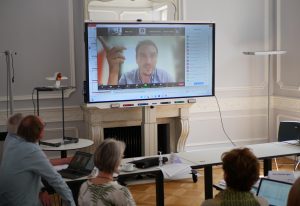
In this context of plurality of meanings, the risks of the very concept of anticipatory governance for the achievement of more responsible science and innovation should not be forgotten, as Alfred Nordman and others have shown. Not only because some anticipatory governance understandings close down the field of possible alternatives and courses of action. (We can call them closed anticipatory governance patterns.) The risks arise above all, however, because anticipatory governance is permanently connected to the risk of instrumentalisation by an innovation system highly committed to techno-industrial developmentalism and economic competitiveness. Therefore, its contribution to responsible science and innovation and its transformative potential should not be taken for granted. Attention needs to be paid to the way in which power relations and instrumentalisation dynamics characteristic of innovation systems tend to exclude, or to close down, the emergence of alternative ways of approaching scientific-technical co-creation. That’s why, among other things, the transformative potential of anticipation towards more responsible forms of scientific practice has to remain analyzed and explored.
Reference
All European Academies (2017), The European Code of Conduct for Research Integrity: https://allea.org/code-of-conduct/
Burgelman J-C, Pascu C, Szkuta K, Von Schomberg R, Karalopoulos A, Repanas K and Schouppe M (2019), Open Science, Open Data, and Open Scholarship: European Policies to Make Science Fit for the Twenty-First Century. Front. Big Data 2:43.
Merton, Robert K. 1979 [1942]. “The Normative Structure of Science.” In The Sociology of Science: Theoretical and Empirical Investigations. Chicago: University of Chicago Press.
Von Schomberg, R (2019), Why responsible innovation in: R. Von Schomberg and J. Hankins (eds) International Handbook on Responsible Innovation: A Global Resource. Cheltenham: Edward Elgar, pp. 12–32.
Rene runs a blog with free downloadable resources on RRI: https://Renevonschomberg.wordpress.com
proposed citation: René von Schomberg and Andoni Ibarra (2022). Introduction to the concepts of Open Science, Responsible Research and Innovation and Anticipatory Governance. https://khk.rwth-aachen.de/2022/07/25/3892/3892/
The Importance of Science Communication Research and of Science Studies for the Region – Opening of the RRC in Dortmund
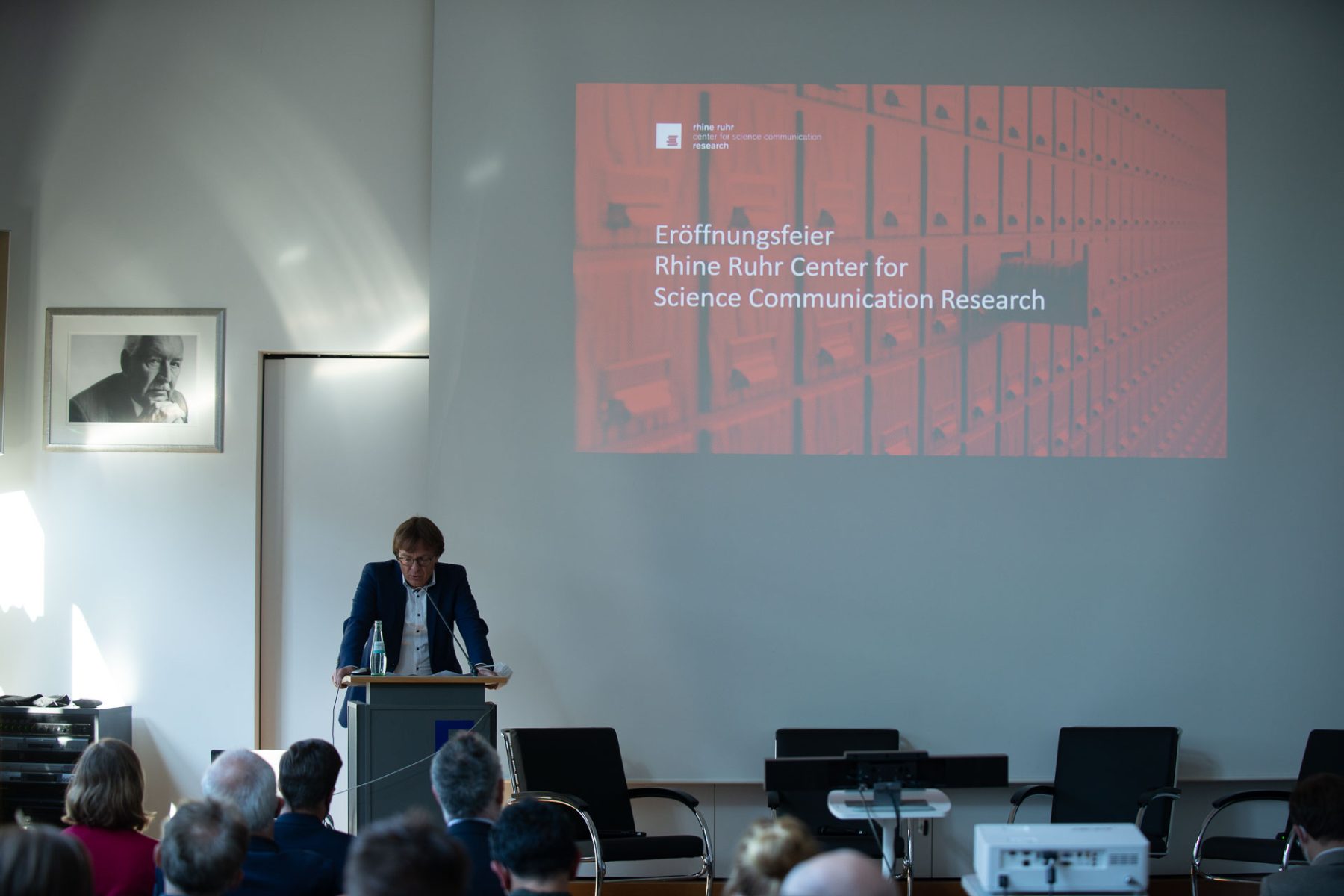
How can science communication be practiced under post-truth conditions? And what role do the humanities and social sciences play in this context? The Rhine Ruhr Center for Science Communication Research (RRC) is devoted to answering these and other pressing questions. The center is funded by a generous grant from the Volkswagen Foundation and headed by Julika Griem of the Kulturwissenschaftliches Institut Essen (KWI), David Kaldewey of the Forum Internationale Wissenschaft (FIW) at the University of Bonn, Holger Wormer of the TU Dortmund, Oliver Ruf of the University of Applied Sciences Bonn-Rhine-Sieg as well as Volker Stollorz of the Science Media Center in Cologne and Franco Zotta of the German Science Journalists’ Association.
The RRC is devoted to science communication with a special focus on the humanities and social sciences. As such, it addresses highly important questions about how insights from the reflexive social and cultural research on science might be communicated. Natural scientists usually attract attention via stimulating images of ground-breaking discoveries. Not so the reflexive sciences on science. Thus, there are elementary questions that need to be answered about the communicability of insights from social and cultural research on science. Next to this, RRC aims to, over the course of its initial five-year funding, bring its findings closer to practicing journalists as well as to students in interdisciplinary workshops and conferences. On June 2, 2022, the RRC officially opened with a celebratory inauguration at the Erich-Brost-Institute at TU Dortmund. Together with our director Stefan Böschen I ventured to Dortmund to attend the event, at which we met with many familiar faces from science studies and journalism.
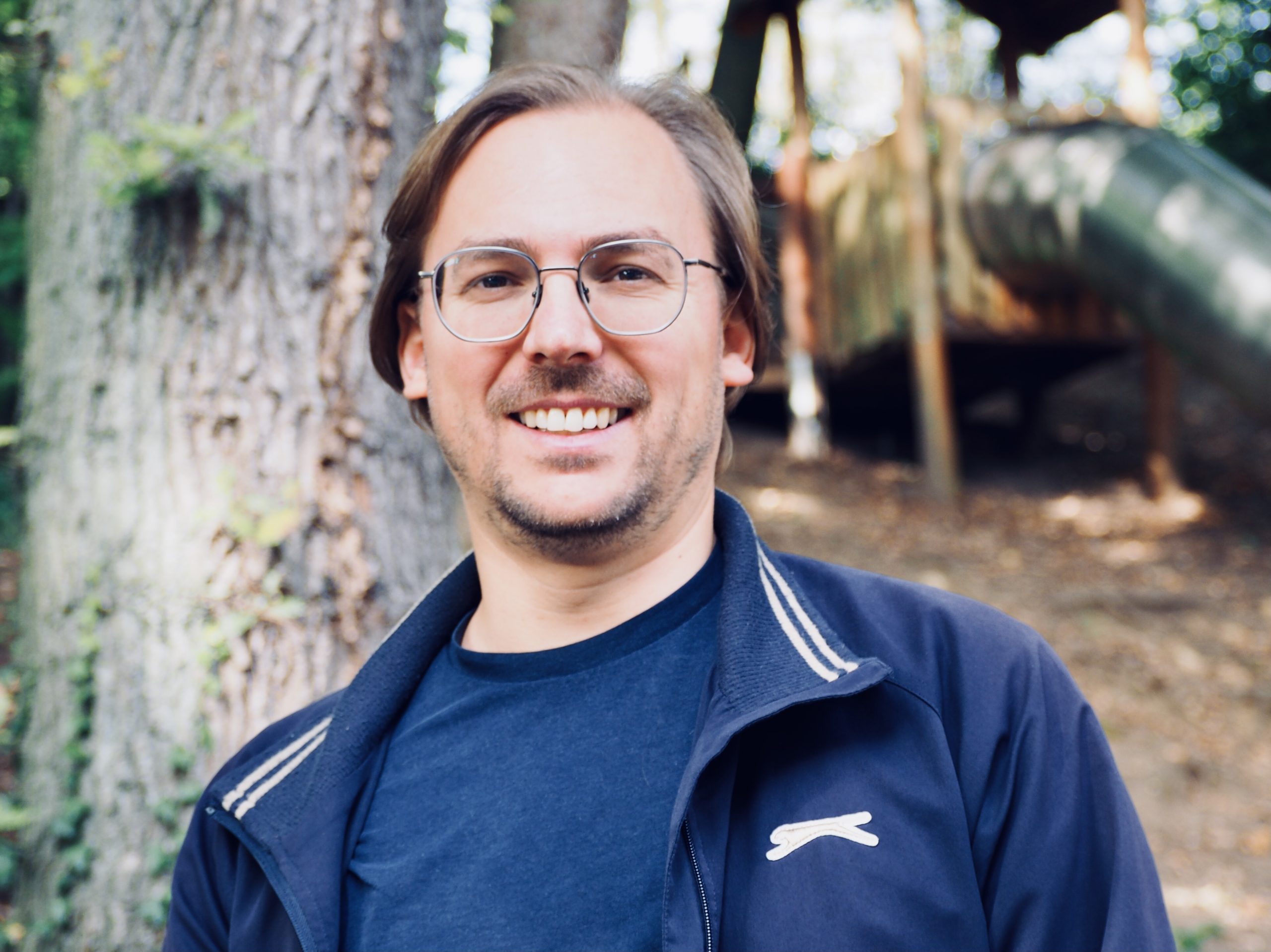
Phillip H. Roth
Phillip is postdoc and the events coordinator at c:o/re. Among other topics, his research is dedicated to questions of identity work in biomedical disciplines, to the meaning of medicine and the role of patient advocacy on the internet as well as to social and cultural conditions of scientific modeling. In a current project, he is trying to develop a sociology of pandemics for the digital age that draws on communication theories of virality and contagion.
After welcoming words by Holger Wormer, the inauguration consisted of a brief overview of the RRC’s three main research projects, given by Julika Griem, as well as three panel discussions, each moderated by one of the RRC’s heads. The panels were devoted to core problem areas of the RRC, making up most the of the formal part of the evening. In the first, moderated by Oliver Ruf, Julia Schubert (University of Speyer) discussed with local students about “Science Communication in Times of Multiple Facts”. One of the core take-aways of this insightful discussion was that the students desired the humanities and social sciences to be more present in public science communication. They stressed particularly that they promised themselves that these fields would be better equipped than natural or engineering sciences to deal with the problems of post-truth in current debates. The second panel, moderated by David Kaldewey, consisted of a dialogue between science journalist Birgit Herden (Die Welt) and the sociologist of science and technology Cornelius Schubert (TU Dortmund) about “Images and Imaginations of Science”. They reflected on how journalism and sociology address different audiences. Variety of audiences necessarily also leads to conflicts between the trajectories of the two professions. While journalism needs to “close” scientific debates to make the topic appealing to its readership, [1]Peter Conrad (1999). Use of Expertise: Sources, Quotes, and Voice in the Reporting of Genetic News. Public Understanding of Science 8 (4): 285–302. https://doi.org/10.1088/0963-6625/8/4/302 a key ambition of science studies, sociology of science or STS is to “open up” the infamous black box of science.[2]Trevor J. Pinch and Wiebe E. Bijker (1984). The Social Construction of Facts and Artefacts: Or How the Sociology of Science and the Sociology of Technology might benefit each other. In Social Studies … Continue reading This is aligned with our effort to “unbox science” here at c:o/re. This ultimately also thwarts any settlement on “the facts”, making science a volatile and (politically) malleable business in sociologists’ eyes, something that is particularly critical under post-truth conditions. However, Schubert also recalls the common heritage of journalism and sociology in the reportages that founded the early-twentieth century Chicago School,[3]https://en.wikipedia.org/wiki/Chicago_school_(sociology) offering hope that each in their own way can contribute to successfully communicating the complexities of scientific research and its findings to the public. In a third session, panellists Eva Weber-Guskar (University of Bochum) and Samir Sellami asked about “A Quality Circle for the Humanities and Social Sciences?” Both are initiators of online platforms – PhilPublica and Soziopolis, respectively – that are devoted to bringing scholarly content to a wide readership. Together with the journalist Volker Stollorz, who moderated the panel, they reminisced whether and how these open formats might provide criteria for the successful communication of scientific content in the digital world. During the informal part of the event – drinks and snacks in the courtyard of the Erich-Brost-Institue while the sun was shining, and the temperatures were warm – we were able to catch up with friends and colleagues after an almost two-year hiatus from in-person events.

A crucial feature of the RRC is that it considers science communication not only from a communication research perspective, but also from a cultural studies (KWI Essen) as well science studies & STS perspective (FIW Bonn). For this reason, we at c:o/re look forward to partnering with the RRC on questions at the intersection of science studies and science communication research. We hope that this partnership will help to unravel what science communication entails in the current mediascape and, also, what we can learn from it practically for communication at c:o/re and elsewhere. Given the grand challenges we face today,[4]David Kaldewey (2018). The Grand Challenges Discourse: Transforming Identiy Wlrk in Science and Science Policy. In Minerva 56: 161-182. https://doi.org/10.1007/s11024-017-9332-2. such as climate change, the digitalization of research practices, energy and mobility transformations, resource scarcity, war and poverty, we also wish that it will strengthen the role of science studies scholarship in the Aachen-Rhine-Ruhr region and in Germany more generally, providing a clearer picture of the role that science can play in facing these challenges.
A first joint conference between the RRC and c:o/re is already in the making and is set to take place in 2023. We will keep you posted as things develop and also about further collaborations between the partners at the RRC and c:o/re. Please also see our events section for infos on further upcoming workshops, lectures and conferences. For now, all that remains is for us to wish our friends at the RRC all the best for their projects. We look forward to the friendly and frequent exchanges about science studies and communication research – cheers!
Proposed citation: Phillip Roth. 2022. The Importance of Science Communication Research and of Science Studies for the Region – Opening of the RRC in Dortmund. https://khk.rwth-aachen.de/2022/06/17/3613/3613/.
References
| ↑1 | Peter Conrad (1999). Use of Expertise: Sources, Quotes, and Voice in the Reporting of Genetic News. Public Understanding of Science 8 (4): 285–302. https://doi.org/10.1088/0963-6625/8/4/302 |
|---|---|
| ↑2 | Trevor J. Pinch and Wiebe E. Bijker (1984). The Social Construction of Facts and Artefacts: Or How the Sociology of Science and the Sociology of Technology might benefit each other. In Social Studies of Science 14 (3): 399-441. You can read the paper here. |
| ↑3 | https://en.wikipedia.org/wiki/Chicago_school_(sociology) |
| ↑4 | David Kaldewey (2018). The Grand Challenges Discourse: Transforming Identiy Wlrk in Science and Science Policy. In Minerva 56: 161-182. https://doi.org/10.1007/s11024-017-9332-2. |
Getting the Measure of Humanity: or, Taking ‘Life is a Work of Art’ Literally
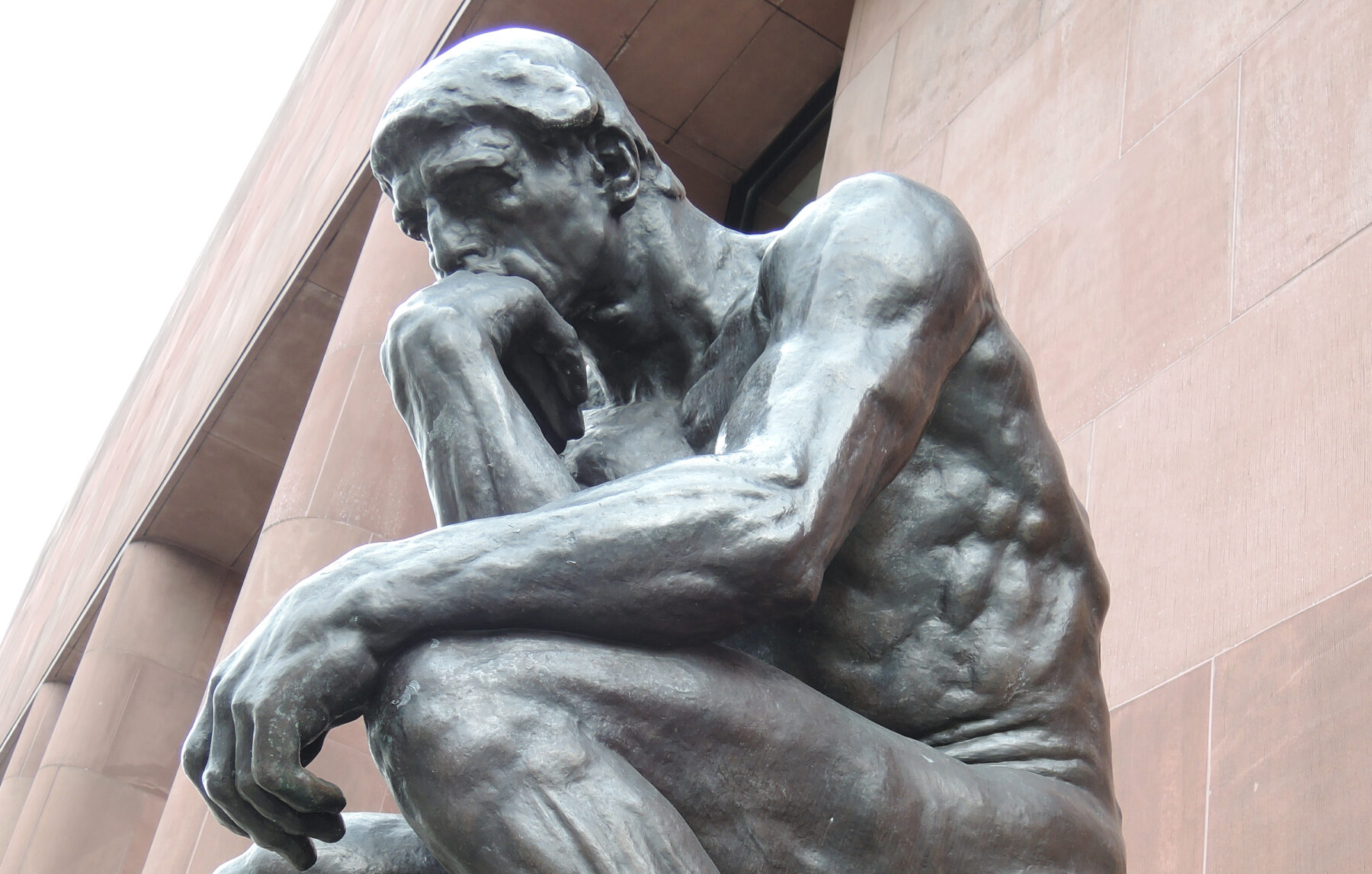
STEVE FULLER
What it means to be ‘human’ and whether the human must be the measure of all minds inevitably returns us to Kant. Kant himself was drawn to the concept of ‘judgement’, which he interpreted in terms of the then-emerging science of ‘aesthetics’. Aesthetics positioned the human as a being called to integrate diverse and often contradictory sensory inputs into a coherent whole in the name of ‘autonomy’, which is in turn exercised through judgement, which of course is also informed by reason. What modern philosophy calls ‘epistemology’ and ‘ethics’ reflects Kant’s view that human judgement forms two rather different but coexistent wholes as part of its ‘worldview’, another term from the aesthetic lexicon. The trajectory out of Kant to the German idealists, Schopenhauer and Nietzsche was largely about trying to achieve a higher, more synthetic aesthetic vision of the world, which typically involved what Nietzsche called a ‘transvaluation’ of the way we see the world from either a strictly epistemological or ethical standpoint.
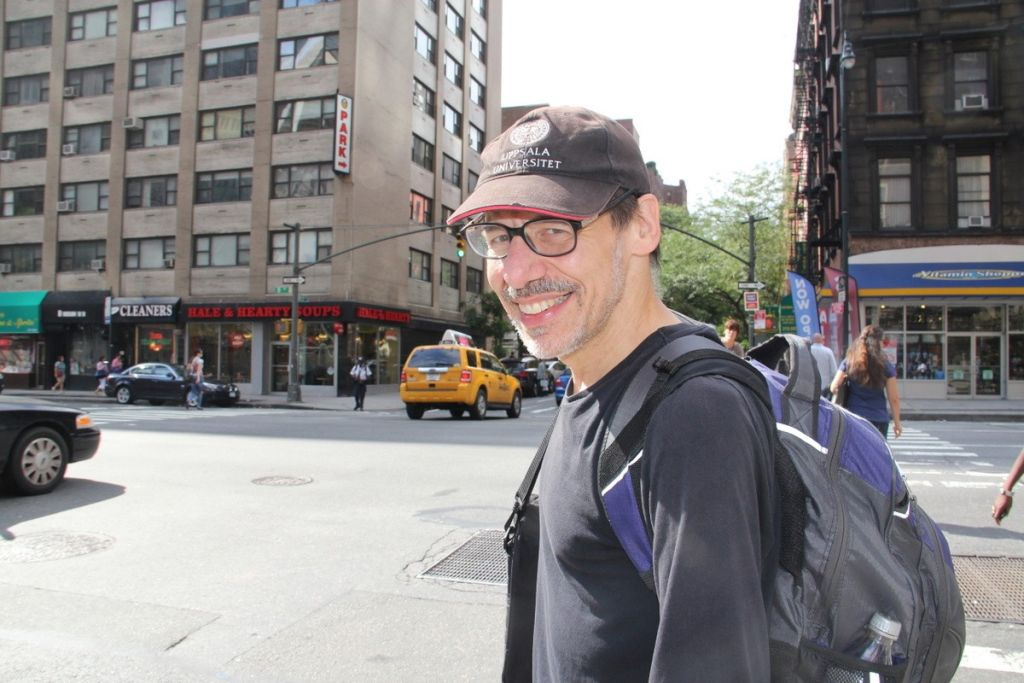
Steve Fuller
Senior Fellow at c:o/re (10/21-09/22)
Steve holds the Auguste Comte Chair in Social Epistemology in the Department of Sociology at the University of Warwick, England. This article is an opening statement for the 18-19 May workshop on ‘The Human Measure and the Measure of All Minds’.
Nietzsche’s somewhat ironic conclusion, already intimated in Kant, is that such a transvaluation would supplant the human with some other kind of being, which we nowadays might call ‘transhuman’ or ‘posthuman’. In effect, the sense of ‘judgement’ that defines the human for Nietzsche is not focused externally on the ultimate cosmic order but internally on the endless, perhaps even Sisyphean task of managing – if not reconciling – what we know and what we want. In this respect, Nietzsche continues to secularize Kant’s original theologically inspired vision of humans as fallen creatures. From this standpoint, the act of passing judgement on another’s humanity – as in the Turing Test – poses a challenge. It is outward looking but it treats the larger world – or more precisely, a candidate alien being – as a canvas on which to project the human; yet the human remains itself a bundle of contradictions, not a template that can simply be imposed.
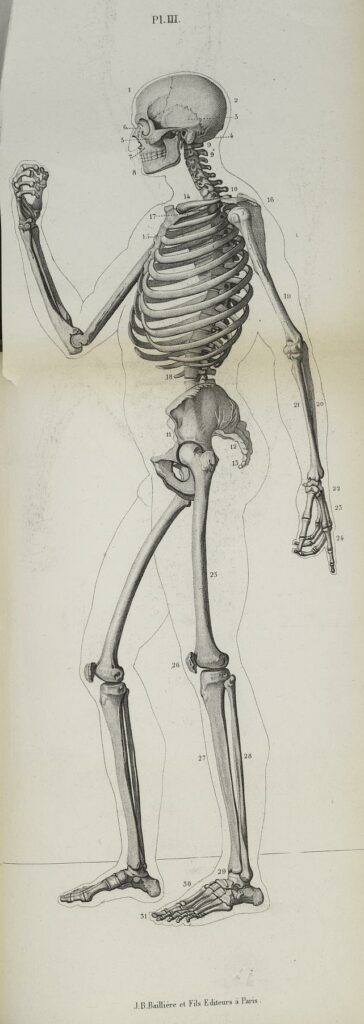
Recent aesthetic theory offers an interesting angle on this dilemma. Nelson Goodman famously proposed that art may be divided into those works that can be forged (because they constitute a unique completed object) and those that cannot be forged (because they can be completed in many ways). He had in mind the distinction between a painting or sculpture, on the one hand, and a musical score or dramatic script, on the other. Against this intuition, Arthur Danto proposed imagining that two artists generate paintings that appear the same to the observer but one used Rembrandt’s method and the other Jackson Pollock’s. Goodman might claim that subtle differences between the two paintings could always be found, based on which one painting might be judged superior and the other perhaps a forgery. However, Danto argues that Goodman’s judgement would probably be based on suspecting that the two paintings had been produced at different times and by different means. For Danto, if you like one, you should like the other. If anything, knowing that they were produced differently should enhance not detract from your aesthetic experience. The Pollock might even be valued more, given the prior improbability of its result.
Danto’s point was designed to undermine the idea of forgery. For him, unlike Goodman, an aesthetic judgement involves treating not only the future but also the past of a candidate work ‘performatively’. Just as we potentially learn something new about music or drama with each new performance, the same applies to our unlearning ideas about the ‘unique craftsmanship’ of a painting or sculpture upon realizing that it can be (and could have been) brought about differently. This sense of temporal symmetry dissolves Goodman’s original distinction. Of course, aesthetic judgement then gets more squarely placed on the shoulders of the judge – and in that sense, becomes more ‘subjective’. Indeed, Danto’s championing of Andy Warhol’s Brillo Box as art led many critics to claim that Danto dissolves the concept of art altogether.
Now applying Danto to Turing, does entertaining a comparably free — ‘morphologically free’, if you will — conception of the human undermine the very concept of humanity? Nietzsche believed that it might but remained agnostic about the consequences – and he was thinking only about how Homo sapiens might be transformed in the future. But why could we not also, á la Danto, discover ‘humans’ who never were Homo sapiens? Moreover, a practical question is attached to the idea of a morphologically free ‘human’. Is a more open conception of what passes as human sustainable in a world with finite resources in many different senses? Kant’s ideal of ‘cosmopolitanism’ suggested an indefinitely expanding circle of humanity, which he associated with collective self-improvement through sustained interaction with ‘alien’ others. Without denying the attractiveness of this ideal, its realizability remains an empirically open question, as non-stereotypically candidate ‘humans’ come forward for recognition.
Reference
Danto, A. (1974). ‘The Transfiguration of the Commonplace’. The Journal of Aesthetics and Art Criticism 33(2): 139-148.
Featured Image: Le Penseur by Rodin, CC BY SA.
Proposed citation: Fuller, Steve. 2022. Getting the Measure of Humanity: Or, Taking ‘Life is a Work of Art’ Literally, https://khk.rwth-aachen.de/2022/05/10/3243/3243/

